

35 Biographies that will Inspire your Middle School Student
Your tweens and teens can learn a ton by reading middle school biographies . Don’t let your middle schooler skip over this genre! There are just too many great books to choose from.
Reading about inspiring lives from the past and present allows kids to learn about the world beyond their own experiences. In addition, reading biographies teaches kids about history, science, sports, and so many other topics that may interest them.
Of course finding books that are challenging enough for a middle school reader without being overly challenging in reading level and content can be tough. This list was gathered specificially for the readers who are “stuck in the middle.”

{This post contains affiliate links. Read my full disclosure .}
Middle School Biographies
These middle school biographies will supplement many homeschool curriculums and make easy additions to any reading list for teens and tweens.
As with any booklist, you make the best choices when it comes to appropriate literature for your child to read. I have read many, though not all, of the books on this list. I highly recommend Common Sense Media when you want to know what sort of content might be included in any book.
A Simple Biography Report
Help your student thoughtfully remember facts from these middle school biographies with this free one-page biography report .
This simple report is perfect for your tween or teen to use to record what they learn as they read. It’s an easy (and fun!) way to report their reading. Ask them to share their findings over dinner if they are willing!

35 Biographies for Teens and Tweens

I am Malala
Malala Yousafai
Two of my kids dove into this one in middle school and couldn’t stop talking about it for quite some time. It opened their eyes to horrible situations in other countries and the courage it takes for one person to stand up to injustice.
Publisher’s Description: “Malala Yousafzai was only ten years old when the Taliban took control of her region. They said music was a crime. They said women weren’t allowed to go to the market. They said girls couldn’t go to school.
Raised in a once-peaceful area of Pakistan transformed by terrorism, Malala was taught to stand up for what she believes. So she fought for her right to be educated. And on October 9, 2012, she nearly lost her life for the cause: She was shot point-blank while riding the bus on her way home from school.
No one expected her to survive.”

Amelia Lost: The Life and Disappearance of Amelia Earhart
Candace Fleming
Publisher’s Description: “On May 21, 1937, the most famous female pilot of all time, Amelia Earhart, set out to do the impossible: circumnavigate the globe at its widest point–27,000 miles in all. Just six weeks later, she disappeared over the Pacific Ocean.
Eighty years have passed since that fateful flight; and still, Amelia’s plane has never been found. Discover the thrilling life and tragic end of America’s most famous trailblazing flier with this impeccably researched and masterfully crafted book from acclaimed author Candace Fleming.”

Becoming Emily: The Life of Emily Dickinson
Krystyna Poray Goddu
Publisher’s Description: “In Becoming Emily, young readers will learn how as a child, an adolescent, and well into adulthood, Dickinson was a lively social being with a warm family life. Highly educated for a girl of her era, she actively engaged in both the academic and social aspects of the schools she attended until she was nearly eighteen.
Her family and friends were important to her, and she was a prolific, thoughtful, and witty correspondent who shared many poems with her closest friends and relatives.
This indispensable resource includes photos, full-length poems, letter excerpts, a time line, source notes, and a bibliography to present a vivid portrait of this singular American poet.”

Promise of Change: One Girl’s Story in the Fight for School Equality
Jo Ann Allen Boyce
From Amazon: “In 1956, one year before federal troops escorted the Little Rock 9 into Central High School, fourteen-year-old Jo Ann Allen was one of twelve African-American students who broke the color barrier and integrated Clinton High School in Tennessee.
At first things went smoothly for the Clinton 12, but then outside agitators interfered, pitting the townspeople against one another. Uneasiness turned into anger, and even the Clinton Twelve themselves wondered if the easier thing to do would be to go back to their old school.
Jo Ann–clear-eyed, practical, tolerant, and popular among both black and white students—found herself called on as the spokesperson of the group. But what about just being a regular teen?”

Alexander Hamilton: The Making of America
Teri Kanefield
Publisher’s Description: “The America that Alexander Hamilton knew was largely agricultural and built on slave labor. He envisioned something else: a multi-racial, urbanized, capitalistic America with a strong central government. He believed that such an America would be a land of opportunity for the poor and the newcomers.
But Hamilton’s vision put him at odds with his archrivals who envisioned a pastoral America of small towns, where governments were local, states would control their own destiny, and the federal government would remain small and weak.
The disputes that arose during America’s first decades continued through American history to our present day. Over time, because of the systems Hamilton set up and the ideas he left, his vision won out.
Here is the story that epitomizes the American dream—a poor immigrant who made good in America. In the end, Hamilton rose from poverty through his intelligence and ability, and did more to shape our country than any of his contemporaries.”

The Boy Who Harnessed the Wind (Young Readers Edition)
William Kamkwamba
From Amazon: “When a terrible drought struck William Kamkwamba’s tiny village in Malawi, his family lost all of the season’s crops, leaving them with nothing to eat and nothing to sell. William began to explore science books in his village library, looking for a solution. There, he came up with the idea that would change his family’s life forever: he could build a windmill. Made out of scrap metal and old bicycle parts, William’s windmill brought electricity to his home and helped his family pump the water they needed to farm the land.”

March: Book One
John Lewis and Andrew Aydin
Who can resist a graphic novel biography ? This has been a popular one in our house with all four kids and myself!
From Amazon: “ March is a vivid first-hand account of John Lewis’ lifelong struggle for civil and human rights, meditating in the modern age on the distance traveled since the days of Jim Crow and segregation. Rooted in Lewis’ personal story, it also reflects on the highs and lows of the broader civil rights movement.
Book One spans John Lewis’ youth in rural Alabama, his life-changing meeting with Martin Luther King, Jr., the birth of the Nashville Student Movement, and their battle to tear down segregation through nonviolent lunch counter sit-ins, building to a stunning climax on the steps of City Hall.”

Thurgood Marshall: The Making of America
From the Publisher: “ Thurgood Marshall , the great-grandson of a slave, was born at a time when African Americans were denied equal rights in America. Segregation was legal. Lynching was common. In some places, African Americans were entirely excluded from public life; they were forbidden to enter public parks and museums or use public swimming pools and restrooms. After being denied admission to the University of Maryland Law School because of his race, Marshall enrolled at Howard University. He graduated first in his class and set out as a young lawyer determined to achieve equality for all Americans. Here is the story of how he did it—how he devised his legal strategy for expanding “we the people” to include all people.”

Turning 15 on the Road to Freedom: My Story of the 1965 Selma Voting Rights March
by Lynda Blackmon Lowery
From the Publisher: “As the youngest marcher in the 1965 voting rights march from Selma to Montgomery, Alabama, Lynda Blackmon Lowery proved that young adults can be heroes. Jailed eleven times before her fifteenth birthday, Lowery fought alongside Martin Luther King, Jr. for the rights of African-Americans.
In this memoir, she shows today’s young readers what it means to fight nonviolently (even when the police are using violence, as in the Bloody Sunday protest) and how it felt to be part of changing American history.”

The Plot to Kill Hitler: Dietrich Bonhoeffer: Pastor, Spy, Unlikely Hero
by Patricia McCormick
From Amazon: “It was April 5, 1943, and the Gestapo would arrive any minute. Dietrich Bonhoeffer had been expecting this day for a long time. He had put his papers in order—and left a few notes specifically for Hitler’s men to see. Two SS agents climbed the stairs and told the boyish-looking Bonhoeffer to come with them. He calmly said good-bye to his parents, put his Bible under his arm, and left. Upstairs there was proof, in his own handwriting, that this quiet young minister was part of a conspiracy to kill Adolf Hitler.
This compelling, brilliantly researched account includes the remarkable discovery that Bonhoeffer was one of the first people to provide evidence to the Allies that Jews were being deported to death camps. It takes readers from his privileged early childhood to the studies and travel that would introduce him to peace activists around the world—eventually putting this gentle, scholarly pacifist on a deadly course to assassinate one of the most ruthless dictators in history.”

Gifted Hands, Revised Kids Edition: The Ben Carson Story
by Gregg Lewis
My son read this book as part of his summer reading in middle school and then we watched the movie . He enjoyed both versions of Ben Caron’s story.
Without a doubt, Ben Carson and all of the amazing medical breakthroughs he is able to achieve are very inspiring.
From the Publisher: “When Ben Carson was in school, his classmates called him the class dummy. Many—including Ben himself—doubted that he would ever amount to anything. But his mother never let him quit. She encouraged Ben to do better and reach higher for his dreams, and eventually, he discovered a deep love of learning.
Today this young boy from the inner-city is one of the world’s greatest pediatric neurosurgeons. Through determination and lot of hard work, Ben overcame his many obstacles and is now dedicated to saving the lives of critically ill children around the world.”
>>> Grab Our FREE Book to Movie Discussion Guide <<<

Abraham Lincoln: Making of America
From the Publisher: “Even though he grew up on the frontier without a formal education, Abraham Lincoln (1809–1865) worked his way up in the government. He was elected to the Illinois House of Representatives, then to the US House of Representatives, and then he became the 16th president of the United States.
During his presidency, he led the United States through the Civil War, brought about the emancipation of the enslaved, and strengthened the federal government.”

Child of the Dream (Memoir of 1963)
by Sharon Robinson
From the Publisher: “ In January 1963, Sharon Robinson turns 13 the night before George Wallace declares on national television “segregation now, segregation tomorrow, segregation forever” in his inauguration speech as governor of Alabama. It is the beginning of a year that will change the course of American history.
As the daughter of baseball legend Jackie Robinson, Sharon has opportunities that most people would never dream of experiencing. Her family hosts multiple fundraisers at their home in Connecticut for the work that Dr. Martin Luther King Jr. is doing. Sharon sees her first concert after going backstage at the Apollo Theater. And her whole family attends the March on Washington for Jobs and Freedom.
But things don’t always feel easy for Sharon. She is one of the only Black children in her wealthy Connecticut neighborhood. Her older brother, Jackie Robinson Jr., is having a hard time trying to live up to his father’s famous name, causing some rifts in the family. And Sharon feels isolated — struggling to find her role in the civil rights movement that is taking place across the country.
This is the story of how one girl finds her voice in the fight for justice and equality.”

A Long Way from Home
Saroo Brierley
From Amazon: “ At only five years old, Saroo Brierley got lost on a train in India. Unable to read or write or recall the name of his hometown or even his own last name, he survived alone for weeks on the rough streets of Calcutta before ultimately being transferred to an agency and adopted by a couple in Australia.
Despite his gratitude, Brierley always wondered about his origins. Eventually, with the advent of Google Earth, he had the opportunity to look for the needle in a haystack he once called home, and pore over satellite images for landmarks he might recognize or mathematical equations that might further narrow down the labyrinthine map of India. One day, after years of searching, he miraculously found what he was looking for and set off to find his family.”
This one is also a major motion picture, so you can follow up with movie after you read the book!

Life in Motion: An Unlikely Ballerina (Young Reader)
by Misty Copeland
From Amazon: “Determination meets dance in this New York Times bestselling memoir by the history-making ballerina Misty Copeland, recounting the story of her journey to become the first African-American principal ballerina at the prestigious American Ballet Theatre.
When she first placed her hands on the barre at an after-school community center, no one expected the undersized, underprivileged, and anxious thirteen-year-old to become one of America’s most groundbreaking dancers .
A true prodigy, she was attempting in months roles that take most dancers years to master. But when Misty became caught between the control and comfort she found in the world of ballet and the harsh realities of her own life, she had to choose to embrace both her identity and her dreams, and find the courage to be one of a kind.”

Andrew Jackson: The Making of America
From the Publisher: “Born in the Carolina backwoods, Jackson joined the American Revolutionary War at the age of thirteen. After a reckless youth of gunfights, gambling, and general mischief, he rose to national fame as the general who defeated the British in the Battle of New Orleans.
Jackson ran for president as a political outsider, championing the interest of common farmers and frontiersmen. Determined to take down the wealthy, well-educated East Coast “elites,” he pledged to destroy the national bank—which he believed was an engine of corruption serving the interest of bankers and industrialists.
A stanch nationalist, he sought to secure and expand the nation’s borders. Believing that “we the people” included white men only, he protected the practice of slavery and opened new lands for white settlers by pushing the Native people westward.
Jackson, a polarizing figure in his era, ignited a populist movement that remains a powerful force in our national politics.”

Elon Musk and the Quest for a Fantastic Future
by Ashlee Vance
This book remains a favorite biography for middle schoolers in my house. My husband read it out loud to my boys and they absolutely loved it.
From Amazon: “The version for adults has been praised as “riveting” (The Financial Times), “spirited” (The Wall Street Journal), and “masterful” (Vice). Now younger readers can read about this innovative leader who is revolutionizing three industries at once: space, automotive, and energy.”

The Lady is a Spy: Virginia Hall, World War II Hero of the French Resistance
Don Mitchell
From Amazon: “When Hitler invaded Poland, Virginia Hall traveled in Europe. Which was dangerous enough, but as fighting erupted, instead of returning home, she headed to France. In a country divided by freedom and fascism, Virginia was determined to do her part for the Allies.
An ordinary woman from Baltimore, Maryland, she dove into the action, first joining a French ambulance unit and later becoming an undercover agent for both the British Office of Strategic Services and the US Office of Strategic Services. Working as a spy in the intelligence network, she made her way to Vichy, coordinating Resistance movements, assisting in Nazi sabotage, and rescuing downed Allies. She passed in plain sight of the enemy and soon found herself being hunted by the Gestapo.
But Virginia cleverly evaded discovery and death, often through bold feats and escapes. Her covert operations, efforts with the Resistance, and risky work as a wireless telegraph operator greatly contributed to the Allies’ eventual win.”

Franklin D. Roosevelt: The Making of America
From the Publisher: “ When Franklin D. Roosevelt was first elected president in 1933, America was in the throes of the Great Depression—the worst economic crisis in U.S. history—and the world was experiencing a menacing rise in Nazism and other dangerous extremists.
Throughout his four presidential terms, Roosevelt was a steady and inspiring leader. He implemented progressive social reform through his New Deal agenda and helped lift America from economic crisis. He guided America to victory in World War II.
Born into wealth and privilege, Roosevelt entered politics at a young age. His career and world views were shaped by his marriage to Eleanor Roosevelt and his long struggle with polio.
Franklin Delano Roosevelt, our thirty-second president, forever left his mark on our nation and the world. By the time of his death, America had grown to a global economic and military superpower. His New Deal legislation changed the relationship of American citizens to their government. His policies came close to fully realizing Alexander Hamilton’s vision of a government that touches and improves the lives of all citizens.

Facing Frederick: The Life of Frederick Douglass, a Monumental American Man
Tonya Bolden
From Amazon: “Teacher. Self-emancipator. Orator. Author. Man. Frederick Douglass (1818–1895) is one of the most important African-American figures in US history, best known, perhaps, for his own emancipation.
But there is much more to Douglass’s story than his time spent in slavery and his famous autobiography. Delving into his family life and travel abroad, this book captures the whole complicated, and at times perplexing, person that he was.
As a statesman, suffragist, writer, newspaperman, and lover of the arts, Douglass the man, rather than the historical icon, is the focus in Facing Frederick.”

Behind Rebel Lines: The Incredible Story of Emma Edmonds, Civil War Spy
Seymour Reit
From Amazon: “In 1861, when war erupted between the States, President Lincoln made an impassioned plea for volunteers. Determined not to remain on the sidelines, Emma Edmonds cropped her hair, donned men’s clothing, and enlisted in the Union Army.
Posing in turn as a slave, peddler, washerwoman, and fop, Emma became a cunning master of disguise, risking discovery and death at every turn behind Confederate lines.”

Susan B. Anthony: The Making of America
From the Publisher: “Susan B. Anthony was born into a world in which men ruled women. A man could beat his wife, take her earrings, have her committed to an asylum based on his word alone, and take her children away from her. While the young nation was ablaze with the radical notion that people could govern themselves, “people” were understood to be white and male. Women were expected to stay out of public life and debates. As Anthony saw the situation, “Women’s subsistence is in the hands of men, and most arbitrarily and unjustly does he exercise his consequent power.” She imagined a different world—one where women and people of color were treated with the same respect that white men were given. Susan B. Anthony explores her life, from childhood to her public career as a radical abolitionist to her rise to become an international leader in the women’s suffrage movement.”

Becoming Kareem: Growing Up On and Off the Court
Kareem Abdul-Jabbar and Raymond Obstfeld
From the Publisher: “At one time, Lew Alcindor was just another kid from New York City with all the usual problems: He struggled with fitting in, with pleasing a strict father, and with overcoming shyness that made him feel socially awkward.
But with a talent for basketball, and an unmatched team of supporters, Lew Alcindor was able to transform and to become Kareem Abdul-Jabbar. “

Never Caught, the Story of Ona Judge: George and Martha Washington’s Courageous Slave Who Dared to Run Away (Young Readers Edition)
Erica Armstrong Dunbar
From Amazon: “In this incredible narrative, Erica Armstrong Dunbar reveals a fascinating and heartbreaking behind-the-scenes look at the Washingtons when they were the First Family—and an in-depth look at their slave, Ona Judge, who dared to escape from one of the nation’s Founding Fathers.”

Freedom Train: The Story of Harriet Tubman
Dorothy Sterling
Publisher’s Description: “Born into slavery, young Harriet Tubman knew only hard work and hunger. Escape seemed impossible – certainly dangerous. Yet Harriet did escape North, by the secret route called the Underground Railroad. Harriet didn’t forget her people. Again and again she risked her life to lead them on the same secret, dangerous journey.”

My Survival: A Girl on Schindler’s List
Joshua M. Greene
From the Publisher: “Rena Finder was only eleven when the Nazis forced her and her family — along with all the other Jewish families — into the ghetto in Krakow, Poland. Rena worked as a slave laborer with scarcely any food and watched as friends and family were sent away.
Then Rena and her mother ended up working for Oskar Schindler, a German businessman who employed Jewish prisoners in his factory and kept them fed and healthy. But Rena’s nightmares were not over. She and her mother were deported to the concentration camp Auschwitz. With great cunning, it was Schindler who set out to help them escape.”

Facing the Lion (Abridged Edition): Memoirs of a Young Girl in Nazi Europe
Simone Arnold Liebster
From the Publisher: “Simone Arnold is an ordinary French schoolgirl—spirited and stubborn. Then the Nazis march in, demanding complete conformity. Friends become enemies. Teachers spout Nazi propaganda. School officials recruit for the Hitler Youth. Simone’s family refuses to heil Hitler as Germany’s savior. They are Jehovah’s Witnesses, and they reject Nazi racism and violence. The Nazi Lion makes them pay the price.”

Reaching for the Moon: The Autobiography of NASA Mathematician Katherine Johnson
Katherine Johnson
From the Publisher: “As a young girl, Katherine Johnson showed an exceptional aptitude for math. In school she quickly skipped ahead several grades and was soon studying complex equations with the support of a professor who saw great promise in her.
But ability and opportunity did not always go hand in hand. As an African American and a girl growing up in an era of brutal racism and sexism, Katherine faced daily challenges.
Still, she lived her life with her father’s words in mind: “You are no better than anyone else, and nobody else is better than you.”
In the early 1950s, Katherine was thrilled to join the organization that would become NASA. She worked on many of NASA’s biggest projects including the Apollo 11 mission that landed the first men on the moon.”

Reach for the Skai: How to Inspire, Empower, and Clapback
Skai Jackson
From the Publisher: “Actress and activist Skai Jackson is a star! Her rise to fame started on the popular Disney Channel shows Bunk’d and Jessie. Her cool sense of style led her to create her own fashion line. And her success has made her a major influencer, with millions of followers on Instagram, who isn’t afraid to stand up for what she believes in.”

The Secret Soldier: Story of Deborah Sampson: The Story of Deborah Sampson
Ann McGovern
From Amazon: “Deborah Sampson wanted to travel and have adventures, but since she had no money, the best way to do that was to join the army. This is the exciting true story of a woman who became a soldier during the American Revolutionary War, by dressing and acting like a man.”

Soul Surfer: A True Story of Faith, Family, and Fighting to Get Back on the Board
Bethany Hamilton
This was a favorite book and story when my girls were in middle school. Bethany was a source of inspiration to them for a long time.
There is also a movie you can watch after you read the book. We did watch the movie, but we had to fast-forward through the shark attack scene because it was too intense for them when they were younger.
From the Publisher: “Soul Surfer is a moving account of Bethany’s life as a young surfer, her recovery after the attack, the adjustments she’s made to her unique surfing style, her unprecedented bid for a top showing in the World Surfing Championships, and, most fundamentally, her belief in God.
It is a story of girl power and spiritual grit that shows the body is no more essential to surfing—perhaps even less so—than the soul.”

The Endless Steppe: Growing Up in Siberia
Esther Hautzig
From the Publisher: “In June 1941, the Rudomin family is arrested by the Russians. They are accused of being capitalists, “enemies of the people.” Forced from their home and friends in Vilna, Poland, they are herded into crowded cattle cars. Their destination: the endless steppe of Siberia.
For five years, Esther and her family lived in exile, weeding potato fields, working in the mines, and struggling to stay alive. But in the middle of hardship and oppression, the strength of their small family sustains them and gives them hope for the future.”

Chasing Space (Young Readers’ Edition)
Leland Melvin
From the Publisher: “When the former Detroit Lion’s football career was cut short by an injury, Leland didn’t waste time mourning his broken dream. Instead, he found a new one—something that was completely out of this world.
He joined NASA, braved an injury that nearly left him permanently deaf, and still managed to muster the courage and resolve to travel to space on the shuttle Atlantis to help build the International Space Station. Leland’s problem-solving methods and can-do attitude turned his impossible-seeming dream into reality.”

The Notorious Benedict Arnold
Steve Sheinkin
From the Publisher: “Most people know that Benedict Arnold was America’s first, most notorious traitor. Few know that he was also one of its greatest Revolutionary War heroes. Steve Sheinkin’s accessible biography, The Notorious Benedict Arnold, introduces young readers to the real Arnold: reckless, heroic, and driven. Packed with first-person accounts, astonishing American Revolution battle scenes, and surprising twists, this is a gripping and true adventure tale from history.”

Ten Days a Madwoman: The Daring Life and Turbulent Times of Nellie Bly
Deborah Noyes
From the Publisher: “Young Nellie Bly had ambitious goals, especially for a woman at the end of the nineteenth century, when the few female journalists were relegated to writing columns about cleaning or fashion.
But fresh off a train from Pittsburgh, Nellie knew she was destined for more and pulled a major journalistic stunt that skyrocketed her to fame: feigning insanity, being committed to the notorious asylum on Blackwell’s Island, and writing a shocking exposé of the clinic’s horrific treatment of its patients. Nellie Bly became a household name and raised awareness of political corruption, poverty, and abuses of human rights. Leading an uncommonly full life, Nellie circled the globe in a record seventy-two days and brought home a pet monkey before marrying an aged millionaire and running his company after his death.”
More Books for Middle Schoolers:
If your student is interested in graphic novels (a very popular option) then these graphic novels for middle schoolers are great options.
Our middle school book club enjoyed these 8 titles this year . They were fantastic reads for great discussions!
While these winter themed books for middle school are great in the winter, they can easily be enjoyed at any time of year.
Don’t forget your FREE one-page biography report:
Additional Biography for Kids Books:
Biography picture books your kids will love.

- Latest Posts
- Ten Best Children’s Poets Your Kids Will Love - April 11, 2024
- The Birchbark House Book Review and Discussion Questions - March 31, 2024
- 30 Family Activities for Teens (that they’ll actually enjoy!) - March 27, 2024
Similar Posts

8 Fantastic Books for your Middle School Book Club
Save or Share:On a quest to find books for our middle school book club, we focused on finding a variety of themes, genres, and a diversity of voices. After much discussion, we are so excited about the list of middle school book club books we selected for the 2020-2021 school year. Middle school is such…

The Best Graphic Novels Your Kids Will Enjoy
Save or Share:This list of graphic novels for kids and tweens is sure to contain a few titles that your child will love. You’ll find adventure stories, fantasy, humor, drama, and more in this collection of graphic novels for kids of all ages. This particular list of graphic novels for kids contains the titles that…

12 Fabulous Books to Read in 8th Grade about Dreaming Big
Save or Share:A list of books to read in 8th grade should include a variety of titles so your middle school child will encounter various time periods, genres, character types, and themes. Middle school is a great time to begin to explore Young Adult titles, but you don’t have to stop including great literature in…

Miss Quinces Book Review and Homeschool Study
Save or Share:Miss Quinces by Kat Fajardo is a story about family, growing up, and being your unique self. The illustrations are vivid and the story is fun. It’s a great story to discuss with kids and tweens which is why I chose Miss Quinces for my kid’s graphic novel online book club in 2024….

63 Thrilling Mystery Books for Kids
Save or Share:A good mystery book for kids is a great way to engage your child in a story they won’t want to put down. From page-turning whodunit books to mysterious events, a mystery book will keep your kids turning pages until the mystery is solved. This post contains affiliate links. Read my full disclosure…

My 2017 Booklist
Save or Share:The summer is coming and reading by the pool is a high priority on my agenda. I love to sit poolside with an iced tea (of course) while reading a good book. In the spirit of the summer season, I decided to organize my reading list. Because it is so huge and I…
Leave a Reply Cancel reply
Your email address will not be published. Required fields are marked *
This site uses Akismet to reduce spam. Learn how your comment data is processed .
Biography Report Form Template and Organizer
A biography is the story of a person’s life. Because of their unique and personal nature, I often choose to include biographies for middle school in our studies of significant historical events. By reading about someone’s personal history and connection to an event, my teens gain valuable insight into the events we’re studying.
There are also times that I have my kids use someone’s biography as the focus of their writing assignment. Over the years we have researched the lives of authors, sports figures, famous historical figures, and tons more.
Occasionally our research is brief and we just review the key facts of a person’s life. Other times we do a more in depth study to understand the time period and circumstances surrounding a person’s accomplishments and contributions to society.
No matter how deep we go into a person’s life, my teens always need an easy way to organize their research.
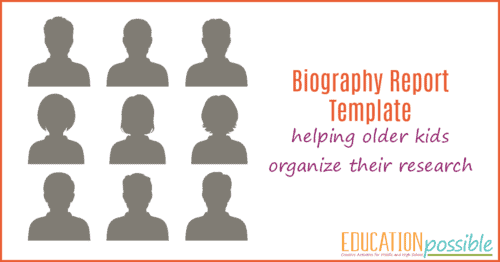
This post contains affiliate links .
That’s why I created this Biography Report Form/Organizer. It’s a great tool that your middle schooler can use to keep track of what they’re learning.
You might chose to have your child complete this form to create a brief biography notebooking page or use the information organized on it as a starting point for a longer writing assignment. Either way, it’s an invaluable tool to use along with any biographical studies you’re doing in your home school.
With this template, your teen will explore topics like:
- Basic biographical information about the person.
- What is this person famous for?
- A quote attributed to him/her.
- If you could ask this person one question, what would it be?
Now that you have the place to record your research, how do you go about finding the information you’ll need to complete it?
Biography Resources
Primary Sources
A primary source is a first-hand account of a topic. You can gather this kind of information by talking to a person directly or by reading letters and other materials the person wrote themselves.
Secondary Sources
A secondary source is an account of a topic that isn’t a primary source. Common ways to get this type of knowledge is through books, newspaper articles, videos, and other media.
There are a number of books and online resources available to help you gather information about the person you are studying. My kids have been fans of the Who Was series (or as we call it, the Big Head books) for years.
Our Favorite Biography Books (series)
- DK Biography Series
- The Who Was Series
And although these books aren’t necessarily a part of a series, they’re still interesting biographies that will inspire your teens .
Not sure which books might be a good fit for your family? You’ll want to read this – which biography series is right for your middle schooler.

Some good online sources we have used include:
- Biographies for Kids
- Biography.com
- Biography Online
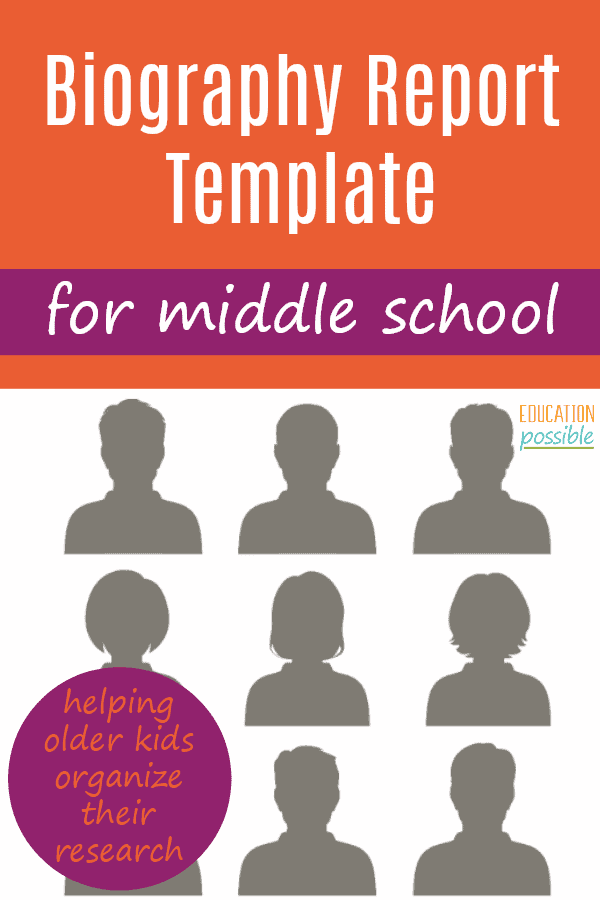
No matter how you decide to do your research, don’t forget to grab a Biography Report Template to make your life easier.
*The free promotion for this has expired, please enjoy this product at a great low price.
Which famous person would your family like to learn mo re about?

Posts Others Love – and You Will Too!

- Pingback: Incredible Homeschool Printable Resources
- Pingback: Which Biography Series is Right for Your Middle School Student?
- Pingback: Tools for Homeschooling Middle School: Teaching History
Comments are closed.

Obsessed With Learning
Helping Teachers Get Their Lives Back

How to Write a Biography: Upper Elementary to Middle School
Writing a biography can be a daunting task. When students hear the assignment of writing a biography, they may have thoughts of long, boring essays or a tedious 10-page book report. There are various ways to tackle writing a biography, and they can even be fun in the process! Let’s look at some less intimidating ways to get your kiddos to write a biography, whether in elementary or middle school.

Step 1: Read a Biography
The first step for students before writing a biography is to read one. They need to see a real-life example before tackling their own biography assignment. Elementary students can read biography picture books or Who Was? biography novels. Biography picture books are especially interesting to students as the splendid pictures bring the person to life.
Here are some picture books we recommend for younger students:
I Am Rosa Parks by Brad Meltzer
The Girl Who Thought in Pictures by Julia Finley Mosca
On a Beam of Light: A Story of Albert Einstein by Jennifer Berne
Upper elementary students love the Who Was? novel series. These books are more challenging, contain some pictures, and are age-appropriate. We recommend:
Who Was? Anne Frank by Anne Abramson
Who Were? The Tuskegee Airmen by Sherri L. Smith
Who Was? Selena by Max Bisantz
Middle school-aged students can read a variety of biographies from sixth graders reading Who Was? to advanced readers conquering even adult biographies. Some biographies or autobiographies my middle school students have read and loved are:
I Am Malala by Malala Youfsazai
Gifted Hands The Ben Carson Story by Gregg Lewis
Life in Motion: An Unlikely Ballerina by Misty Copeland
Step 2: Research a Person
Once students have read a biography to gain an understanding of what one looks like and how it is organized, as well as more about the person they are learning about, they can complete research from the biography or autobiography. A simple graphic organizer to help students organize crucial information would suffice. Important information that the student should gather from their book includes:
- Birthdate and Birthplace
- Death Date and Place If Deceased
- Childhood/Family
- Adult Family
- Major Accomplishments
- Major Obstacles
- Lessons we can learn from this person’s life
Step 3: How to Write a Biography Tips
As a teacher, you can provide choices for students or provide a project students can tackle. Some biography projects require students to write a biography in a different format than a typical essay.
Paper Bag Biography
For elementary grades, a paper bag biography book report is an interesting way to create a biography. Once students have read their biography or autobiography, they color the front of the paper bag with a picture of the person as well as display the person’s name. On the back of the paper bag is written the major accomplishments, obstacles, and a lesson learned from this person’s life.
On one side of the bag is written fun facts and on the other side is written basic information such as birthdate, birthplace, family, death date, etc. Inside the paper bag, students place varying objects that symbolize the life of the person and explain or write about them.
Cereal Box Biography
This same concept can be completed with a cereal box. Students would utilize construction paper and glue over the cereal box instead. They can create a cute name for their cereal that coincides with the person they’re learning about as well. For instance, a biography about Sugar Ray Leonard, a professional boxer, could become Sugar Rays on a cereal box biography report.
Pizza Box Biography
Speaking of food, a pizza box biography report is something I have utilized for years in the classroom. It combines creativity, art, and writing to display a biography. A simple Google search can give you tons of templates, instructions, and student sample pictures to choose from. I’m not certain of the original creator of this project, but it is amazing!
Students decorate the outside and inside cover of a pizza box with pictures and facts of their person. Next, they create a pizza out of construction paper and each slice displays important information. They can use their creativity to decorate each slice with toppings. Some students create a flap that goes over their slice of information and on the flap are toppings they’ve drawn such as mushrooms, pepperoni, and peppers. I am always impressed with how students use their creativity to design elaborate pizzas!
Here is the link to a FREE pizza box biography book report guideline I have used for years.

Biography in a Can
Keeping with the theme of biography projects centered around food containers, have your students grab a clean chip or coffee can (with a lid). After reading a biography, students will decorate their can based on whom they’re learning about. We recommend the Who Is? , Who Was? and I Am books for this.
Next, students will use a graphic organizer to gather information from their book and then turn that research into an index card biography report. The various index cards are then stored inside the can for easy access for presentations. This project promotes independent student research, incorporates art, and is plain fun. It is definitely engaging for students.
Grab the whole project, including graphic organizers , index card templates , a pre-design sheet , and a rubric below.

Grab your Biography Research Project today.
Our Biography Research Project will guide your students through Biography Research with ease. In addition, this unique research project helps them to learn more about important figures, as well as write and create some awesome biographies.
Bonus: Our Biography Research Project is a great way to display your students’ work for the admiration of parents, admin, and fellow students. Your class will be the envy of your school.
MLA Biography Essa y
As students move into seventh and eighth grade, there is a huge focus on learning to write an MLA essay. Because of this, I require students to write a biography essay or book report. Using a detailed template, students write their biographies. Each paragraph is thoroughly explained and chunked to display the life of the person they’re investigating. Here is a simple template of how I have seventh-grade students organize their biography essays:
1st paragraph contains:
Title of your biography and the author’s name. The book is a biography of __________, who was born on (Date) ______________ in (Birthplace) ____________________. Why did you choose to read this book? Write a brief summary of their well-known accomplishments.
2nd, 3rd, 4th Paragraph contains:
A summary of their life. Make sure their life is in sequence. Tell of major life accomplishments, major disappointments, and major obstacles they faced. Tell of their childhood, adulthood, etc.
5th Paragraph contains:
What is the most interesting fact about this person? Explain why. How would you describe this person? If you could meet your person, what questions would you ask him or her? Why? Would you recommend this biography to a friend? Why or why not?
6th Paragraph: Conclusion Paragraph
What are the major life lessons a reader can learn from this person’s life?
Step 4: Publish through Technology
Students can create biography presentations by using Google Slides , all the while utilizing pictures, quotes, and thematic decor to make their project come to life. Slidesgo.com is an amazing template resource in which students can make their presentations fit a theme and be a bit more aesthetically pleasing and exciting.
Furthermore, Canva has a plethora of resources students can use to create biographies, from a standard presentation to infographics to creating an eBook . Canva is an awesome resource. It contains varying fonts, pre-loaded graphics, and the ability to upload pictures online. Canva has become a favorite tool of our students here lately!
Writing a biography can be challenging but in a great way! Reading biographies such as picture books to novels, this readily prepares students to conquer biography writing. By presenting options such as activities or a detailed template for an essay, students can feel interested and ready to tackle the world of biographies.

Share this:
- Click to share on Twitter (Opens in new window)
- Click to share on Facebook (Opens in new window)
- Click to share on Pinterest (Opens in new window)
Leave a Reply Cancel reply
Discover more from obsessed with learning.
Subscribe now to keep reading and get access to the full archive.
Type your email…
Continue reading
You must be logged in to post a comment.
Biography Project: Research and Class Presentation
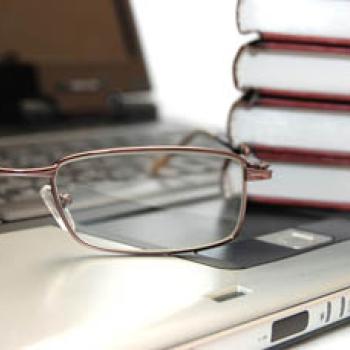
- Resources & Preparation
- Instructional Plan
- Related Resources
Set the stage for high-interest reading with a purpose through a biography project. Students work together to generate questions they would like to answer about several well-known people, then each student chooses one of these and finds information by reading a biography from the library and doing Internet research. Students create a graphic organizer (a web) to organize the facts they have found and share what they have learned about their subjects through oral presentations. Students evaluate themselves and their classmates by using a rubric during the research and graphic organizer-creation process and by giving written feedback on one another's presentations.
Featured Resources
Bio-Cube : This planning tool can help students organize their research; use it as an extension to the lesson and have them outline the lives they' researched before writing their own biographies.
From Theory to Practice
- By using graphic organizers, students write or draw meanings and relationships of underlying ideas. This has been shown to improve students' ability to recall content.
- By summarizing information, students improve in including ideas related to the main idea, generalizing, and removing redundancy.
- By working in cooperative groups, students may increase their learning of reading strategies through peer discussion. They may also lead to better comprehension.
Common Core Standards
This resource has been aligned to the Common Core State Standards for states in which they have been adopted. If a state does not appear in the drop-down, CCSS alignments are forthcoming.
State Standards
This lesson has been aligned to standards in the following states. If a state does not appear in the drop-down, standard alignments are not currently available for that state.
NCTE/IRA National Standards for the English Language Arts
- 7. Students conduct research on issues and interests by generating ideas and questions, and by posing problems. They gather, evaluate, and synthesize data from a variety of sources (e.g., print and nonprint texts, artifacts, people) to communicate their discoveries in ways that suit their purpose and audience.
- 8. Students use a variety of technological and information resources (e.g., libraries, databases, computer networks, video) to gather and synthesize information and to create and communicate knowledge.
- 12. Students use spoken, written, and visual language to accomplish their own purposes (e.g., for learning, enjoyment, persuasion, and the exchange of information).
Materials and Technology
- School or classroom library with a broad selection of biographies
- Computers with Internet access and printing capability
- Index cards
- Oral Presentation Peer Feedback Form
- Oral Presentation Rubric
Student Objectives
Students will
- Learn to ask relevant questions before beginning a research project
- Learn to take notes and categorize information as they create graphic organizers
- Improve comprehension as they read and skim text for main ideas and details
- Develop research skills (book and Internet) with the purpose of teaching the class what they have learned
- Think critically as they use rubrics and written feedback to evaluate their classmates and themselves
Session 1: Before Reading
Sessions 2 to 5, session 6: after reading, sessions 7 to 9: class presentations.
Have students use their webs and the online Bio-Cube tool to plan and write biographies of the person they have researched. When they are finished, ask students to share the books with a younger class.
Student Assessment / Reflections
Possible student assessments include:
- Use the Web Rubric to grade the students' webs.
- Use the Oral Presentation Rubric to grade students' presentations based on the quality and completeness of information given.
- Observe and evaluate students' participation in group work and ability to critique other students' presentations based on their comments on the Oral Presentation Peer Feedback Form .
- Calendar Activities
- Lesson Plans
- Strategy Guides
Add new comment
- Print this resource
Explore Resources by Grade
- Kindergarten K
Assignment Biography: Student Criteria and Rubric for Writing
Researching an Individual Aligned to Common Core Writing Standards
- Tips & Strategies
- An Introduction to Teaching
- Policies & Discipline
- Community Involvement
- School Administration
- Technology in the Classroom
- Teaching Adult Learners
- Issues In Education
- Teaching Resources
- Becoming A Teacher
- Assessments & Tests
- Elementary Education
- Secondary Education
- Special Education
- Homeschooling
- M.A., English, Western Connecticut State University
- B.S., Education, Southern Connecticut State University
The genre of biography can also be categorized in the sub-genre of narrative nonfiction/historical nonfiction. When a teacher assigns a biography as a writing assignment, the purpose is to have a student utilize multiple research tools to gather and to synthesize information that may be used as evidence in a written report about an individual. The evidence gained from research can include a person’s words, actions, journals, reactions, related books, interviews with friends, relatives, associates, and enemies. The historical context is equally important. Since there are people who have influenced every academic discipline, assigning a biography can be a cross-disciplinary or inter-disciplinary writing assignment.
Middle and high school teachers should allow students to have a choice in selecting the subject for a biography. Providing student choice, particularly for students in grades 7-12, increases their engagement and their motivation especially if students select individuals they care about. Students would find it difficult to write about a person they do not like. Such an attitude compromises the process of researching and writing the biography.
According to by Judith L. Irvin, Julie Meltzer and Melinda S. Dukes in their book Taking Action on Adolescent Literacy:
"As humans, we are motivated to engage when we are interested or have real purpose for doing so. So motivation to engage [students] is the first step on the road to improving literacy habits and skills" (Chapter 1).
Students should find at least three different sources (if possible) to make sure the biography is accurate. A good biography is well-balanced and objective. That means if there is disagreement between sources, the student can use the evidence to state that there is a conflict. Students should know that a good biography is more than a timeline of events in a person's life.
The context of a person's life is important. Students should include information about the historical time period in which a subject lived and did her/his work.
In addition, the student should have a purpose for researching another person's life. For example, the purpose for a student to research and write a biography can be in a response to the prompt:
"How does this writing this biography help me to understand the influence of this person on history, and quite possibly, this person's impact on me?"
The following standards-based criteria and scoring rubrics can be used to grade a student-selected biography. Both criteria and rubrics should be given to students before they begin their work.
Criteria for a Student Biography aligned to Common Core State Standards
A General Outline for Biography Details
- Birthdate /Birthplace
- Death (if applicable).
- Family Members.
- Miscellaneous (religion, titles, etc).
Education/Influences
- Schooling.Training.
- Work Experiences.
- Contemporaries/Relationships.
Accomplishments/ Significance
- Evidence of major accomplishments.
- Evidence of minor accomplishments (if relevant).
- The analysis that supports why the individual was worthy of note in their field of expertise during his or her life.
- Analysis why this individual is worthy of note in their field of expertise today.
Quotes/Publications
- Statements made.
- Works published.
Biography Organization using the CCSS Anchor Writing Standards
- Transitions are effective in assisting the reader to understand shifts.
- Ideas within each paragraph are fully developed.
- Each point is supported by evidence.
- All evidence is relevant.
- Important terms are explained to the reader.
- Purpose of each paragraph (introduction, body paragraphs, conclusion) is clear.
- Clear relationship between topic sentence(s) and paragraph(s) that came before is evident.
Grading Rubric: Holistic Standards with Letter Grade Conversions
(based on extended response Smarter Balanced Assessment writing rubric)
Score: 4 or Letter Grade: A
Student response is a thorough elaboration of the support/evidence on the topic (individual) including the effective use of source material. The response clearly and effectively develops ideas, using precise language:
- Comprehensive evidence (facts and details) from source materials are integrated.
- Relevant, and specific clear citations or attribution to source materials.
- Effective use of a variety of elaborative techniques.
- Vocabulary is clearly appropriate for the audience and purpose.
- Effective, appropriate style enhances content.
Score: 3 Letter Grade: B
Student response is an adequate elaboration of the support/evidence in the biography that includes the use of source materials. The student response adequately develops ideas, employing a mix of precise and more general language:
- Adequate evidence (facts and details) from the source materials is integrated and relevant, yet the evidence and explanation may be general.
- Adequate use of citations or attribution to the source material.
- Adequate use of some elaborative techniques.
- Vocabulary is generally appropriate for the audience and purpose.
- The style is generally appropriate for the audience and purpose.
Score: 2 Letter Grade: C
Student response is uneven with a cursory elaboration of the support/evidence in the biography that includes the uneven or limited use of source material. The student response develops ideas unevenly, using simplistic language:
- Some evidence (facts and details) from the source materials may be weakly integrated, imprecise, repetitive, vague, and/or copied.
- Weak use of citations or attribution to source materials.
- Weak or uneven use of elaborative techniques.
- Development may consist primarily of source summaries.
- Vocabulary use is uneven or somewhat ineffective for the audience and purpose.
- Inconsistent or weak attempt to create the appropriate style.
Score: 1 Letter Grade: D
Student response provides a minimal elaboration of the support/evidence in the biography that includes little or no use of source material. The student response is vague, lacks clarity, or is confusing:
- Evidence (facts and details) from the source material is minimal, irrelevant, absent, incorrectly used.
- Insufficient use of citations or attribution to the source material.
- Minimal, if any, use of elaborative techniques.
- Vocabulary is limited or ineffective for the audience and purpose.
- Little or no evidence of appropriate style.
- Insufficient or plagiarized (copied without credit) text.
- Off-topic.
- Off-purpose.
- Grading for Proficiency in the World of 4.0 GPAs
- How to Write an Interesting Biography
- T.E.S.T. Season for Grades 7-12
- Topics for a Lesson Plan Template
- The Whys and How-tos for Group Writing in All Content Areas
- How to Create a Rubric in 6 Steps
- Definition and Examples of Analysis in Composition
- Beef Up Critical Thinking and Writing Skills: Comparison Essays
- What Is Plagiarism?
- What Is a Rubric?
- Writing Prompt (Composition)
- 10 Strategies to Increase Student Reading Comprehension
- A Sample Lesson Plan for Teaching Geometry Using 'The Greedy Triangle'
- Development in Composition: Building an Essay
- The Ultimate Guide to the 5-Paragraph Essay
- Biographies: The Stories of Humanity
- Skip to primary navigation
- Skip to main content
- Skip to primary sidebar
- Skip to footer

Thrifty in Third Grade
By Cassie Smith - Engaging Elementary Resources
Teaching Students to Write Biography Reports
Biographies are many students’ first glimpse at history. It is one of my favorite units to teach every year. It is a great opportunity for students to read, research, use technology, and write!
If you’re teaching students to write biography reports this year, then check out how I like to break it down!
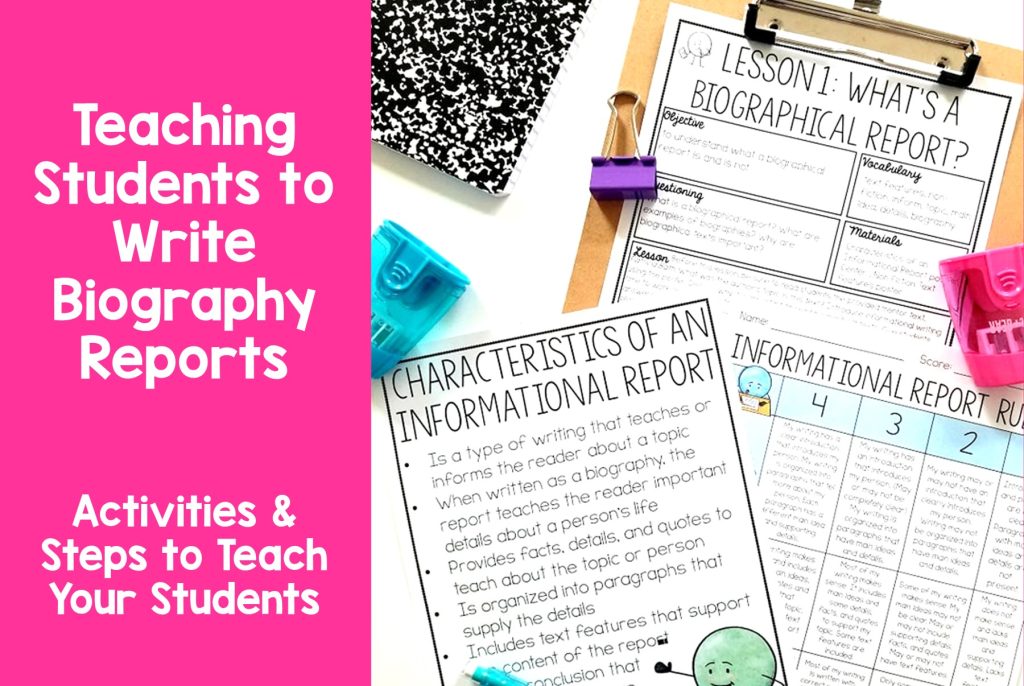
Breaking Down Writing a Biography Report (Grades 2-5)
Writing these types of reports is part of the Common Core writing standards for Grades 2-5 as well as many other states’ standards. There are several steps to take as you teach your students to write a biography report.
The first step ALWAYS: Introduce Biographies
Before I even begin to teach my students how to write a biography, I like to read several from our school library.
For second and third grade students :
- Have several biographies in the classroom and give students time to explore the books. Then discuss: What did you notice about all these books? How are they the same? How are they different?
- Discuss genre and introduce biographies.
- Then, I would read them biographies about many different people.
For fourth and fifth grade students :
- Make a class anchor chart discussing what you already know about biographies. Look for gaps in understanding, and make sure students know the main characteristics of a biography.
- Then, read several different biographies about the same person with a focus on the different information each biography shared, as well as what information was the same. Did all of the biographies have the characteristics we listed on our anchor chart?

It is important to make note of the characteristics that biographies have so that when students write their own, they already have an understanding of how they are written!

Once students have been exposed to biographies, you can begin to teach about writing them.
Discuss Text Structure of Biographies
Depending on the grade you teach, you may not necessarily call it “text structure,” however it is important for students to understand that most biographies are written in a chronological/sequential way.
Since we are writing about someone’s life, it wouldn’t make sense for the report to be out of order.
While we go over this, I like to create a timeline with my students.

If you are using my biography writing units, I recommend:
- Using the mentor text to create a timeline of the subject’s life. You can do this on the board or on chart paper.
- Use the research text to create a timeline of the subject’s life (this is the person the students will write about, and a text is included in the units). For older students, you may choose to have them fill out the timeline on their own.
How to Write an Engaging Introduction for the Biography Report
At the beginning of the report, students should write an engaging introduction that includes one (or both) of two main components.
The introduction should include one (or both) of these components:
- Introduce the subject with their full name and birth information or
- Briefly preview what they are most famous for

Practice writing a variety of introductions and have students choose the one they like the best. ( TIP: Model some poorly written introductions as well , and discuss why those are not a good fit!)
Crafting the Body Paragraphs of the Biography Report
When teaching your students to write biography reports, it is important to explain to them what the body paragraphs should include.
The body paragraphs should include the major events in the person’s life.
Read over the body paragraphs from your mentor text and discuss what was included and what was not included. What was included in the timeline you created? What did you leave out?

You can make a T chart with your students and discuss what are major events in your own life, and what are not.
Writing a Conclusion for the Biography Report
Most conclusions in a biography end with the person’s death.
While this can be noted, it’s important for students to understand that they shouldn’t just end their report with “and then they died in 1894”. It is more important for them to end their report with the legacy of the person.
To help students understand what a person’s legacy means:
- Review and write legacies of other famous individuals from biographies you have read to your class.
- Ask them what their person is most known for (and review their introduction).
- Ask them how this person has impacted other people.
If you are looking for resources for teaching your students to write a biography report, check out my writing units.
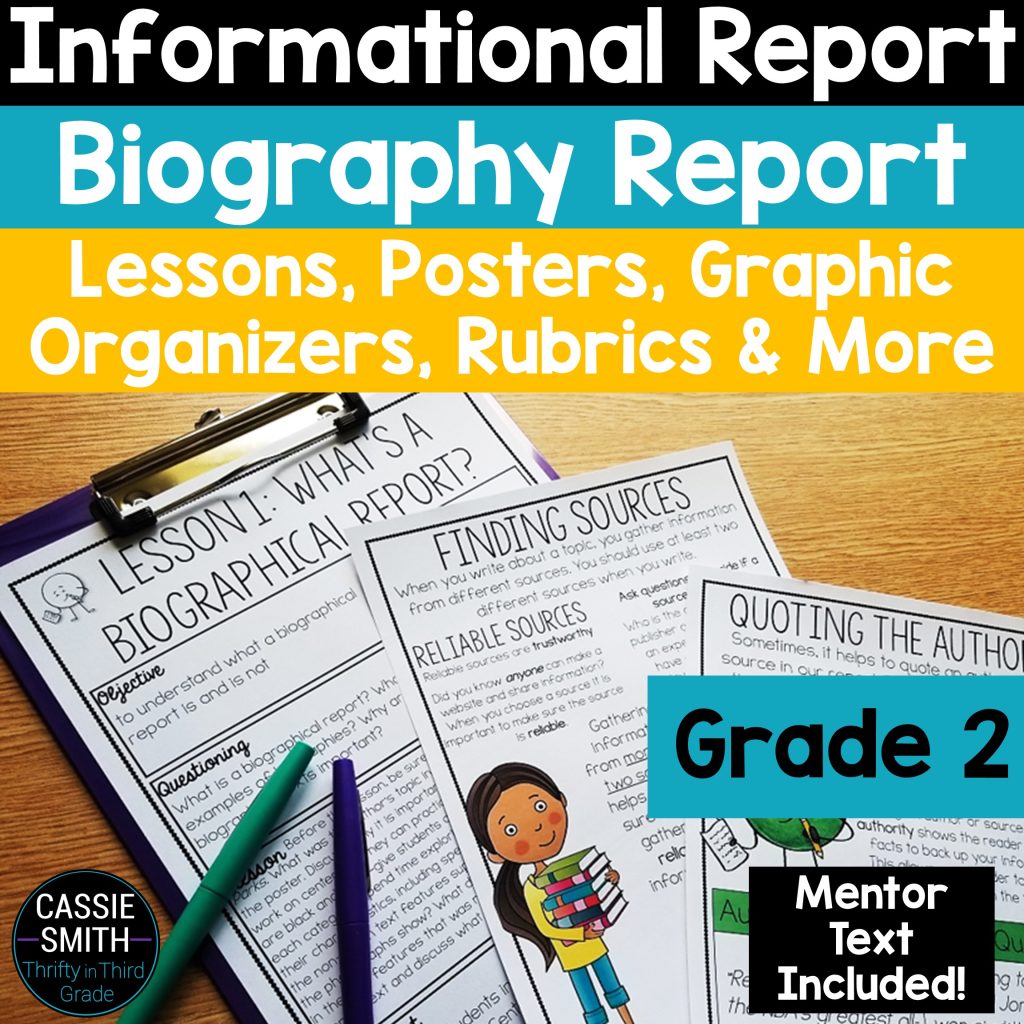
These units also include a Google Slides option so you can teach the whole unit digitally!
Preview the grades 2-5 biography writing units here:.
Get resources for teaching your Grades 2-5 students to write a biography report here.
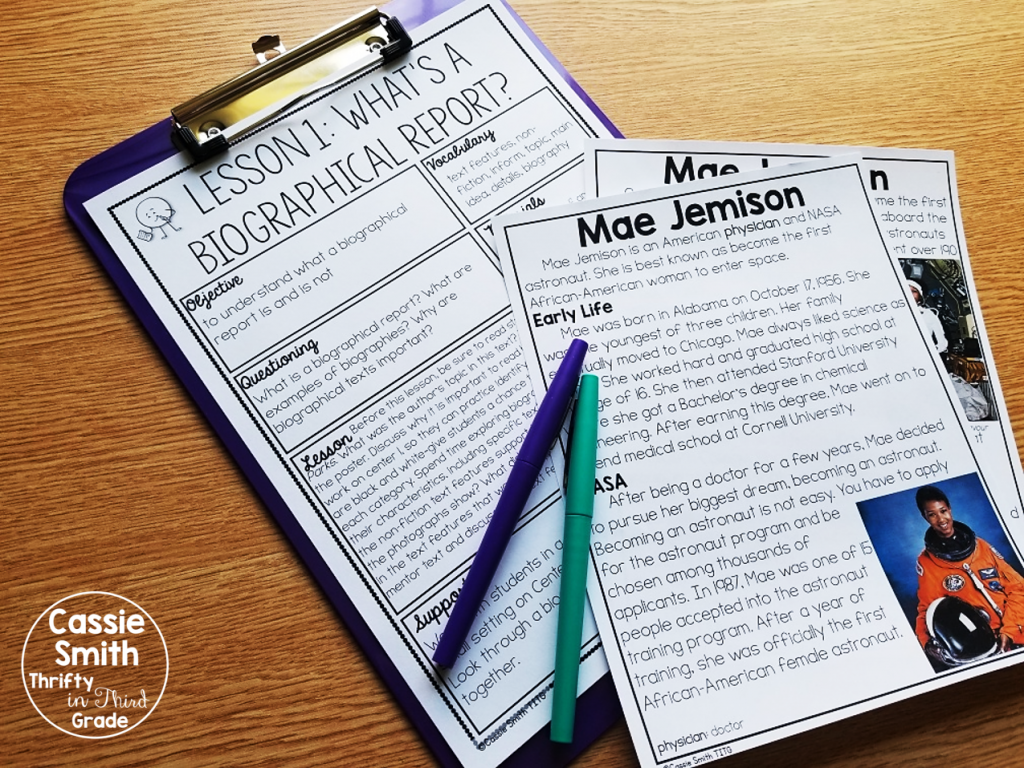
Reader Interactions
January 6, 2021 at 8:47 am
Your blogs are always very useful! Thank you for sharing your talents!
Meet Cassie
I’m Cassie Smith and I’m so glad you decided to stop by. I am passionate about creating engaging curriculum for teachers in grades K-5! I believe learning can be fun AND aligned to standards! Learn More
Looking for something?
- About Cassie
- ABCs of Salvation
- Privacy Policy
- Terms of Use
- Disclaimers
Let’s Connect
Get support.
Come join our Elementary Teachers Support Group on Facebook! You’ll be able to collaborate and get tips from thousands of teachers just like you!
Get a Surprise!
Sign up for our email list and we'll send a surprise freebie right to your inbox!
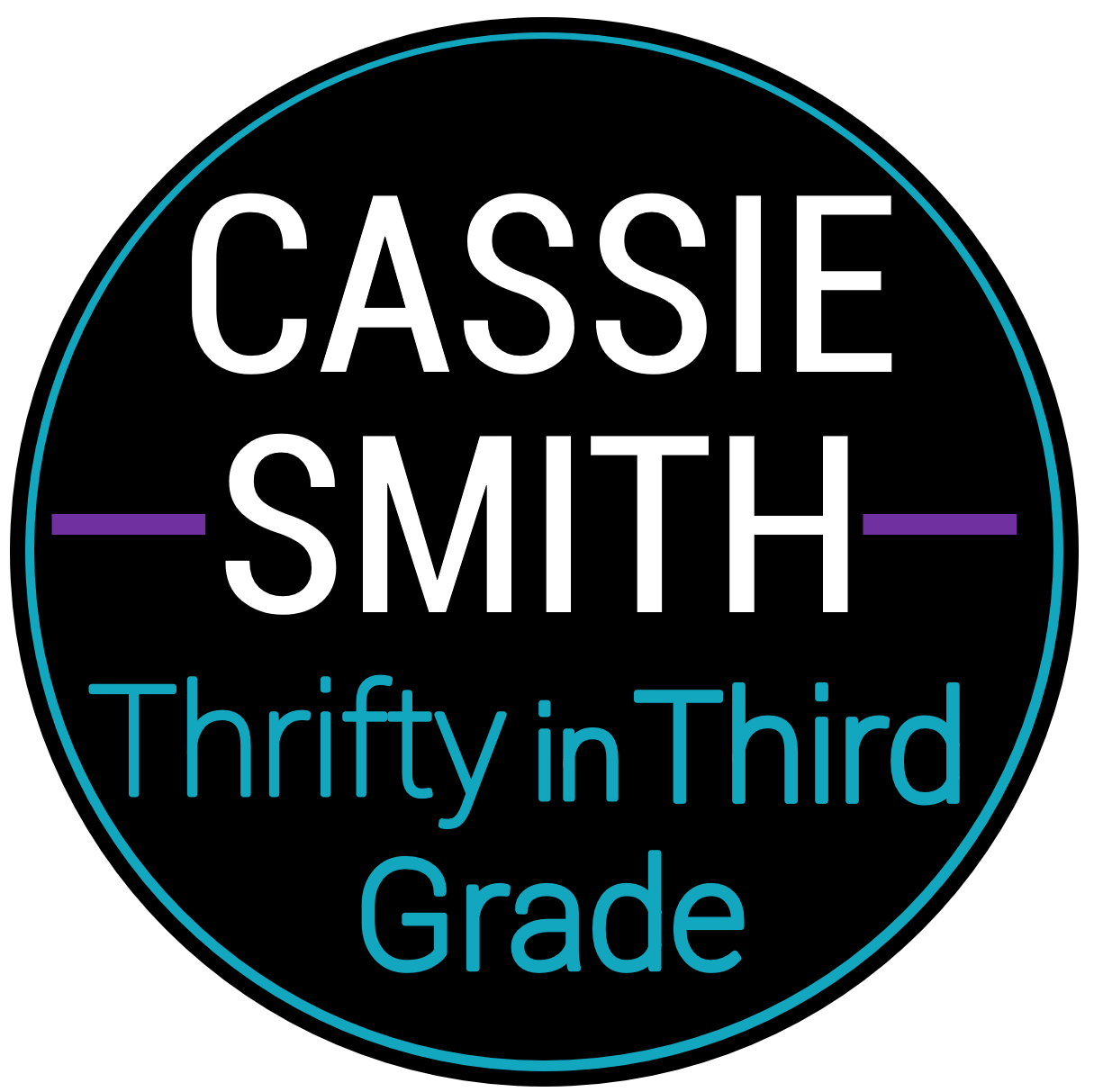
Over 6,200 homeschool resources and growing!

Biography Research for Kids {Facts, Templates & Printables}
Published: September 6, 2022
Contributor: Jeannette Tuionetoa
Disclosure: This post may contain affiliate links, meaning if you decide to make a purchase via my links, I may earn a commission at no additional cost to you. See my disclosure for more info.
The telling of a person’s life could be one of the most personal literature pieces your children will read while in school. Learn how to teach biography research for kids in an easy way so they can write their very own biography report.
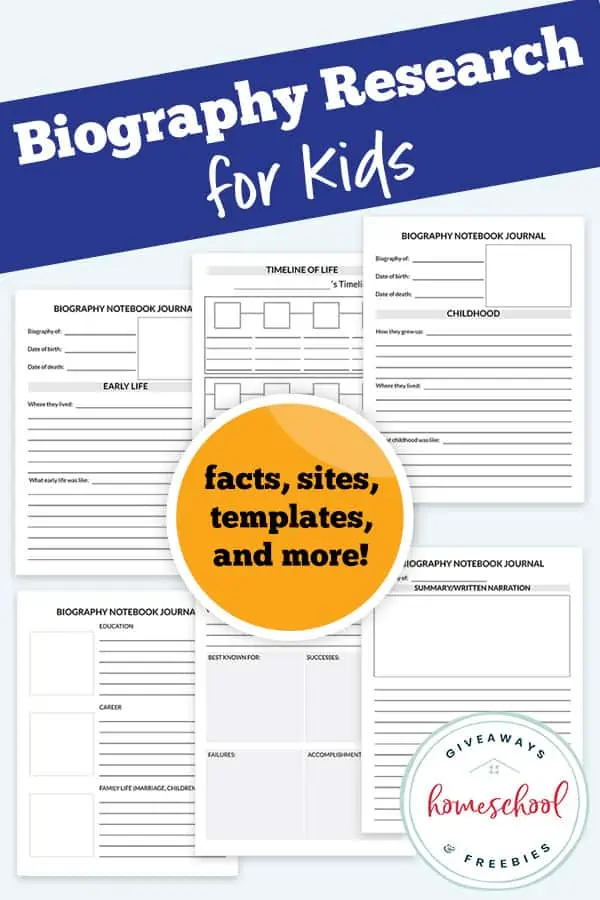
Biography Research for Kids
To obtain correct information about a particular person (famous person or historical figure), it is important to gather as much information as possible. To ensure the information you find is accurate, the sources you use should be reliable and should be cross-checked with other information.
Biography Facts for Kids
Before tackling biography research for kids, it is important they know what a biography is and what it is not. Here are a few important things to know about biography in literature lessons.
A biography is a story about a particular person’s life, whether it be a famous person, athlete, historical figure, or a specific person.
Biographies of people are written in third person , meaning it is about someone else. In contrast, an autobiography is a person themselves telling their life story.
The Purpose of a Biography
Many times biographies of people are used as historical accounts of an era. Biographies tell basic facts about people, their education, work, and relationships. Yet, they also are personal accounts and portrayals of experiences through events of the time in their life story.
What are the key features of a biography?
There are key features of a biography that make this literary artwork a retelling of a life story. Here are a few key features of biography to get a child’s mind in the flow of gathering information for a biography research project, author study, or important events for biography research.
- date and place of birth and/or death
- where the public figure lived or location of residence
- educational background
- professional experience (i.e. work, artwork, skills, hobbies)
- area of expertise (What was/is this person famous for?)
- major achievements in life (Which of the areas of expertise was he/she best known for?)
- expound on the information, find interesting facts, and include your thoughts.
How to Write a Biography
There are specific ways to keep focused when writing a biography. Explore these steps to help your students write and understand biographies.

Step One: Choose Who to Write About
There are loads of famous, historical, or note-worthy people your young readers can explore for their biography research project .
Parents can task a specific genre study of biographies or specific categories for students to research, or students can choose their own. Here are some interesting biography research topics students will enjoy learning about:
Interesting Biography Figures
- Sports figure
- Someone from American history
- Someone from a specific historical period like ancient civilizations/ ancient times
- Black History Month figure
- Native American figure
- Presidents of the United States (biographies of presidents)
- World War I or World War II figures
- American Revolution figure
- Renaissance figure
- Middle Ages figure
- 20th-century heroes
Historical Figures and Public Figures
- Amelia Earhart
- Elizabeth Carter
- Frida Kahlo
- Harriet Tubman
- Ruby Bridge
- Misty Copeland
- Ellen Ochoa
- Martin Luther King Jr.
- William Shakespeare
- Life Of George Washington
- Frederick Douglass
- Julius Caesar
- Jackie Robinson
- James Boswell
- Wright Brothers
Step Two: Do Your Research
Gathering information for research through primary and secondary sources is crucial. Compiling good research data is important and valuable for building knowledge and clear a path for learning.
Gathering reliable research helps students understand topics, understand issues, increase awareness, and exercise the mind.
Using Primary Sources
When students use primary resources, they gather reliable knowledge that answers research questions, enables critical thinking, and develop well, thought out interpretations from facts.
Primary resources are images, artifacts, and documents that are firsthand testimony and proven evidence on a topic.
Some more examples of primary sources:
- Manuscripts
- Video recordings
Using Secondary Sources
Secondary sources, on the other hand, describe, comment on, evaluate, discuss, or process what would be in a primary source.
Some examples of secondary sources are:
- Biographical texts
- Literature reviews
- Commentaries
- History books
- Bibliographies
- Dictionaries/encyclopedias
Step Three: Create an Outline
The next step in writing a research-rich biography is creating an outline to organize the information and content gathered.
Outlines, although many students might not think they are useful, aid in their writing process. They provide the writers with a structure to follow, making sure no important information is missed.
You can use the Biography Notebooking Journal to make this an easy process! The templates can be used to do a thorough biographical research project .
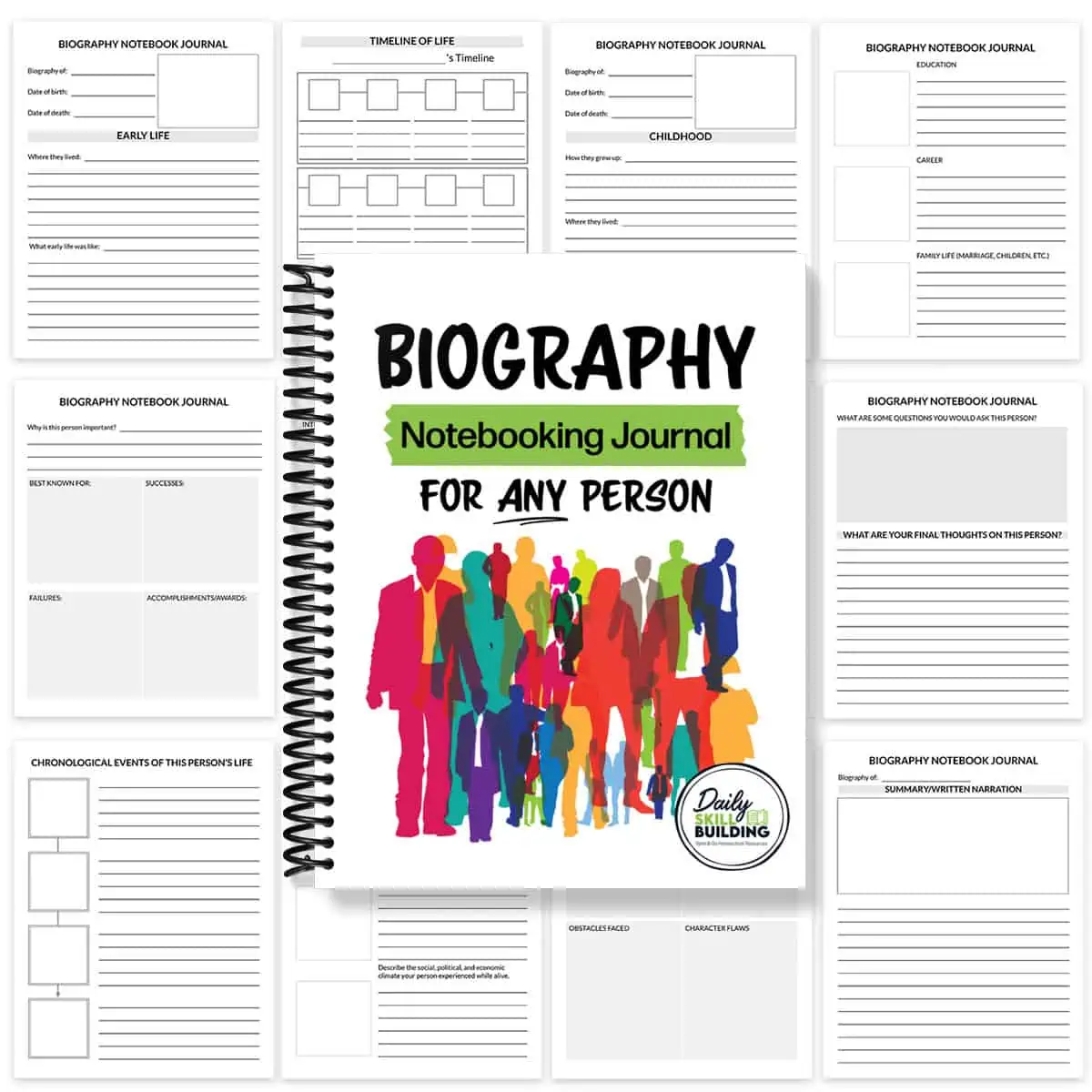
Biography Research Outline
A research paper is enhanced with an outline by organizing thoughts, understanding a clear flow is needed for information, and then again, ensuring nothing is forgotten.
Here is a very basic research outline:
INTRODUCTION
- Develop an engaging introduction sentence that captures the reader’s attention.
- Site a quote or anecdote from the person’s life.
- Describe the basic identity of the person with the very basic key elements mentioned above (i.e. name, date of birth/death, location).
- Include a unique observation that you have gathered from the person or why you chose to write about him/her.
- Stick to the theme of your research paper and provide the content you have gathered in your research.
- Describe the information you have gathered in sections or chronologically.
- Discuss your person’s accomplishments and their impact on society or those around them. Maybe also mention, if applicable, how a major event changed their life or the life of others.
- Ensure the pieces of information gathered are connected or interlinked or flow well together.
- Mention the person’s legacy or why they will remain important to remember or acknowledge.
- Add a lesser-known fact about the person, something you found interesting or noteworthy.
- Conclude with a comment or your input of the impact the person will make or will leave on the world or society.
Write a First Draft
Making an outline is crucial for getting an overview of what a research biography paper will be. Look like. If done correctly, it will easily flow into a first draft.
The outline develops what you need as a first draft, and transition words will help the writer make the paragraphs and sections flow into each other smoothly. The below resources will help with both.
How to Write a Paragraph for Kids – Teach your children how to write well, thought-out paragraphs as a foundational writing skill in your homeschool. This post explores ten different steps for writing a paragraph and listing the essential parts of a good paragraph.
Transition Words – Your children will find these writing tools helpful for words and phrases they can use to show smooth storytelling transitions.
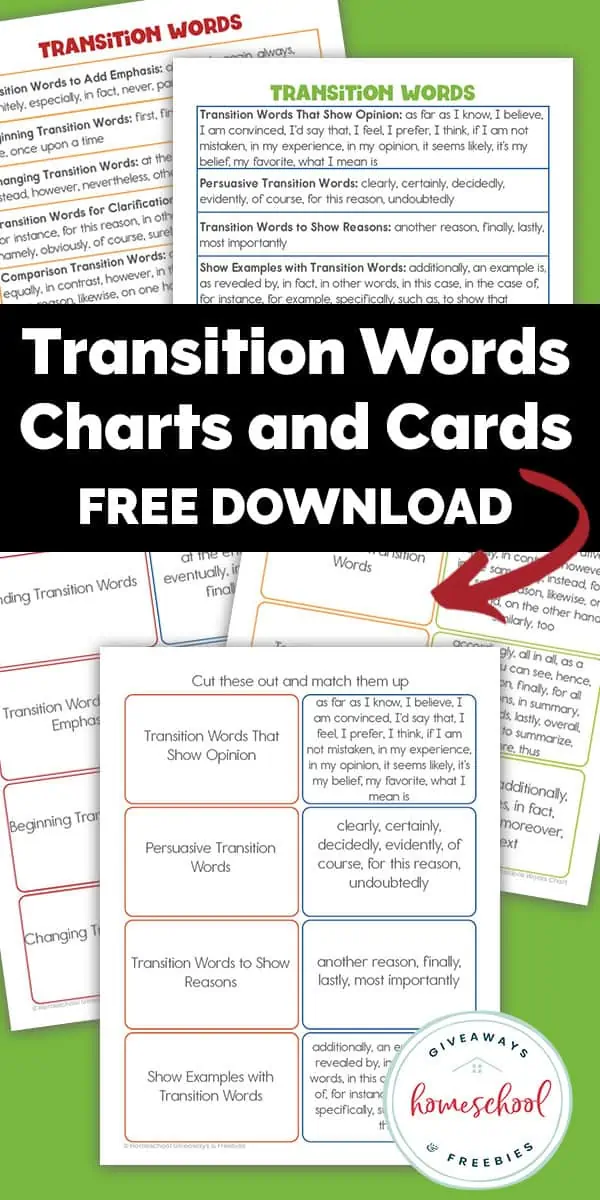
Edit and Revise
In the editing and revision page of a research biography unit paper, the writer can enhance effective headings and subheadings for their paragraphs. This is the time to:
- Information aligns with your main point or purpose of the research paper.
- Eliminate parts of the paper that do not add value.
- Tighten up the wording (i.e. if your sentences are understandable or make sense)
- Check for spelling and grammatical errors.
- Get someone to read your paper or write it, then do another read-over the next day – for a fresh perspective.
Write Your Final Paper
It is time. Type or write out the final paper. Make a cover page if needed, evaluate if your sources are cited correctly, and develop your bibliography page, if required.
Citing Your Sources
It is important to cite sources for research biographies and any other assignments students have in school. Determine what citation style is needed and teach children how to cite correctly. This resource will benefit students straight through high school, college, and any written work they may create.
Research and Citation Resources by Owl Purdue – This tool is a perfect resource for conducting research, using the research, determining citation style, and citing written works correctly.
Biographical Websites
To jump-start the minds of young girls and boys when they begin researching biographies, the websites below will assist set the stage for their journey into learning about biographies of people, their hard work, and more.
Biographies of People in History
Biography – This is one of the most popular internet sites capturing the most interesting stories about massive amounts of people in our world. You will find compelling points of view and true stories about people from our world.
Info Please – This site is a search engine for biographies by category. There are all types of categories to choose from like Arts and Entertainment, Politics and Government, Famous Americans by Race and Ethnicity, and so much more.
Time 100 Most Influential People – Time magazine has brought their Time Most Influential People online. Check out Time’s 100 Most Influential People for 2020 to help students search for biographical information, including pioneers, artists, leaders, titans, icons, and more.
Scientists Biographies
Famous Scientists – Check out this alphabetical list of hundreds of famous scientists who have impacted our world’s history. Even search scientists by categories like Astronomers, Chemists, Biologists, and more.
World of Scientific Biography – Science World presents a whole section on biographies for scientists in various branches of the science field. The biographical data is separated by gender, minority status, historical periods, nationality, and prize winners.
People and Discoveries by PBS – Learn all about people and their discoveries in this databank which includes about 120 entries about 20th century scientists and their life stories.
Artists Biographies
Van Gogh’s Gallery of Artist Biographies – Although this site is about Vincent Van Gogh, it also offers biographical information on other artists like Michelangelo, Gauguin, Caravaggio, and Claude Monet.
If your child enjoys learning about artists, you can find all types of tips for an artist study, like how long a student should be on one artist study, famous artists to study per grade level, and so much more.
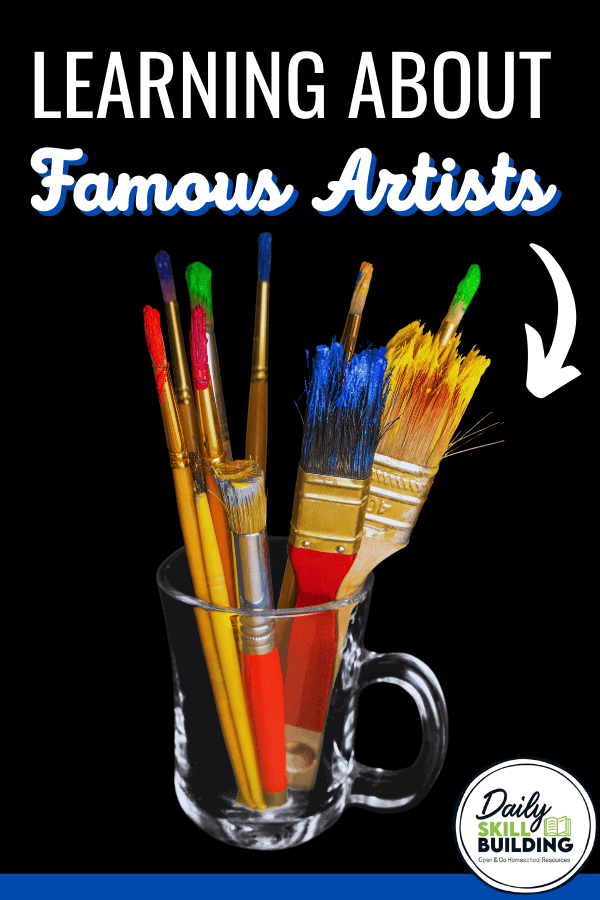
Biographies of Poets
All About Poets – You don’t have to be an expert on poetry to help students learn about poets and their artwork. Check out Poets.org to search more than 3,000 biographies on poets of both contemporary and classical styles.
Athlete Biographies
ESPN’s Top Athletes of the Century – Use your child’s love of sports to enhance their learning experience in their English classes. Students will enjoy the biographies of great athletes of the 20th century.
Biographies of Presidents
POTUS History and Data – It is important for students to learn about the Presidents of the United States (POTUS). This site has loads of information to help with a biography research assignment. The POTUS site includes presidential facts, quizzes, and even Presidential firsts. You can even use this unit for an overview of the U.S. Presidents timeline . These president fact sheets are also super helpful.
Biographies of Nobel Prize Recipients
Nobel Prize Awards – The Nobel Prize is an international award by the Nobel Foundation in Stockholm, Sweden. This site is a great way of learning about all the Nobel prize winners and what they were nominated for.
Biographies of Famous People
Who2 Biographies – This biographical resource holds 4,775 biographies of famous people, characters, and even creatures. Search these by categories that include born today, by occupation, cause of death, and more.
Smithsonian’s Spotlight Biography – Searching Smithsonian Education is a fun way to learn about famous and notable American artists, athletes, soldiers, scientists, inventors, social reformers, and others.

To Summarize, a Biography Should Include:
Biographies can be very interesting topics and a fun way to marry various subjects in your homeschool like history, writing, reading, English, research, and more.
Biographical research for kids includes:
- Narrowing down a person to research.
- Putting research skills into practice to gather all the information needed.
- Writing a detailed outline.
- Writing an introduction, body, and conclusion.
- Selecting a good image for the person chosen.
Every person is created for a purpose. Focusing on biography research for kids allows students to take interest in the lives of others. Begin encouraging your student to take an interest and learn about others this school year.
Jeannette Tuionetoa
Jeannette is a wife, mother and homeschooling mom. She has been mightily, saved by grace and is grateful for God’s sovereignty throughout her life’s journey. She has a Bachelor in English Education and her MBA. Jeannette is bi-lingual and currently lives in the Tongan Islands of the South Pacific. She posts daily freebies for homeschoolers!
Related resources
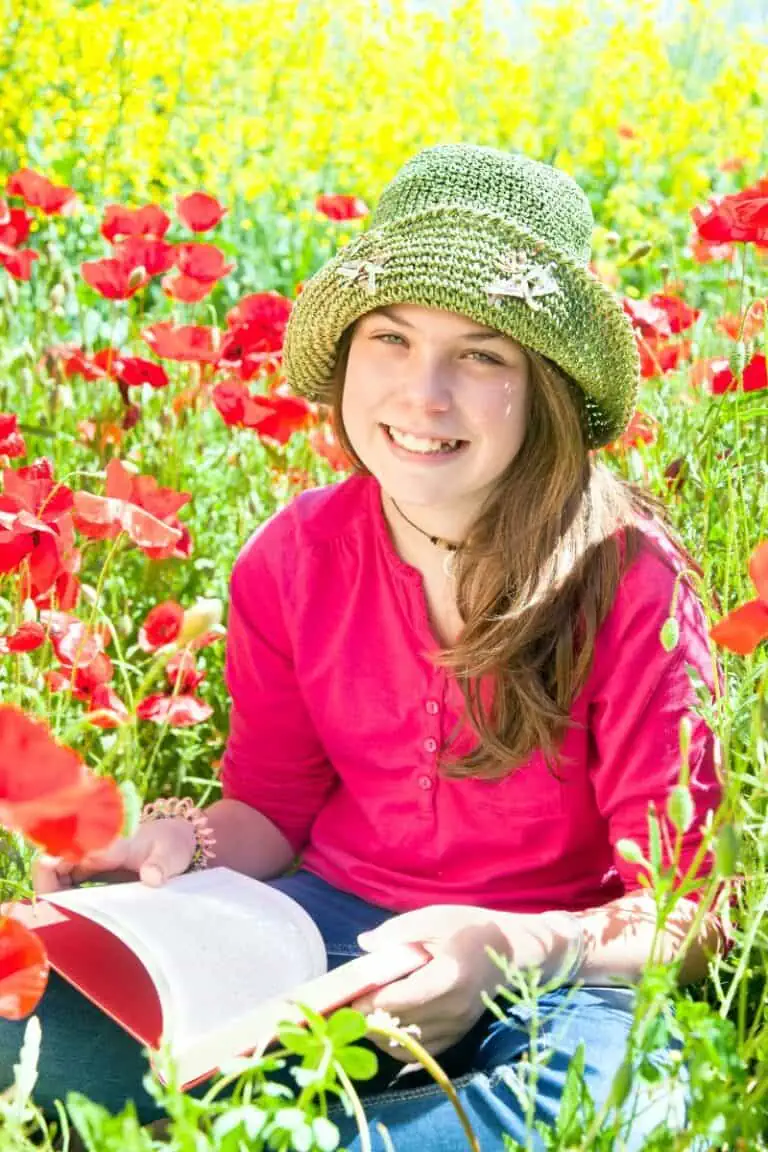
All 37 Dear Canada Books in Order
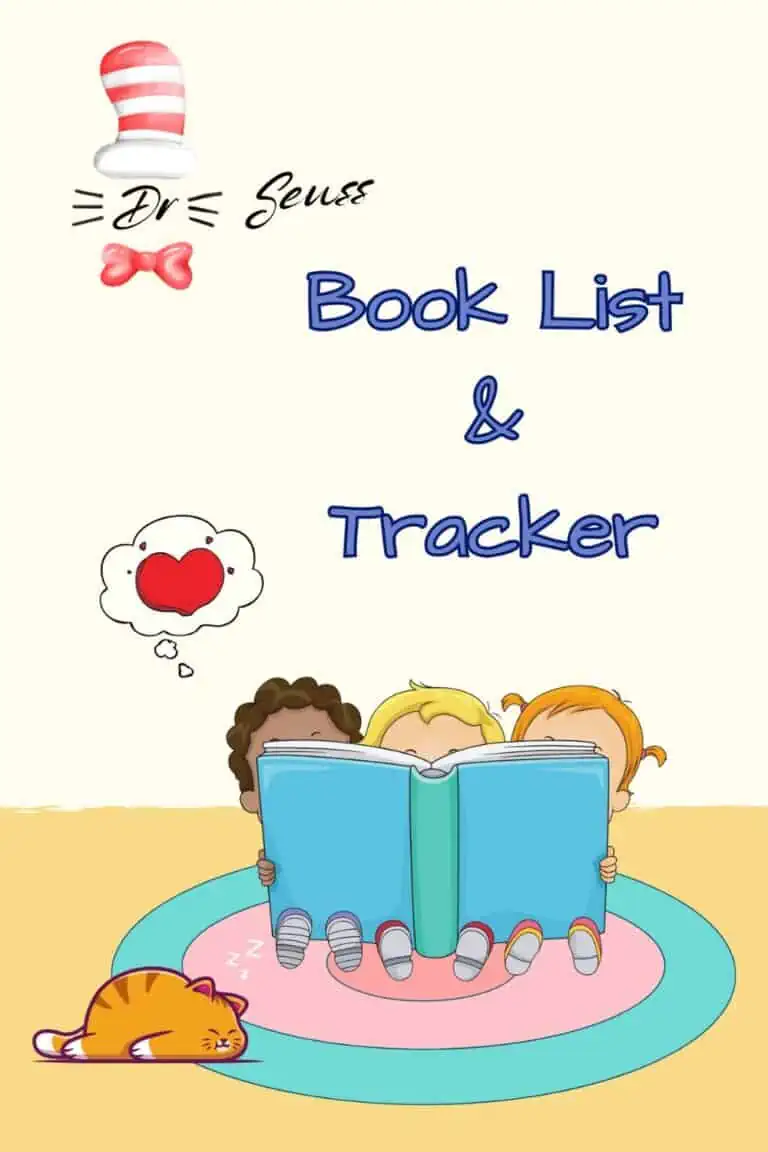
Printable List of Dr. Seuss Books in Order of Publication

Common Words that Rhyme With You (Printable Games)

150 + Words That End With O for Fun Word Games
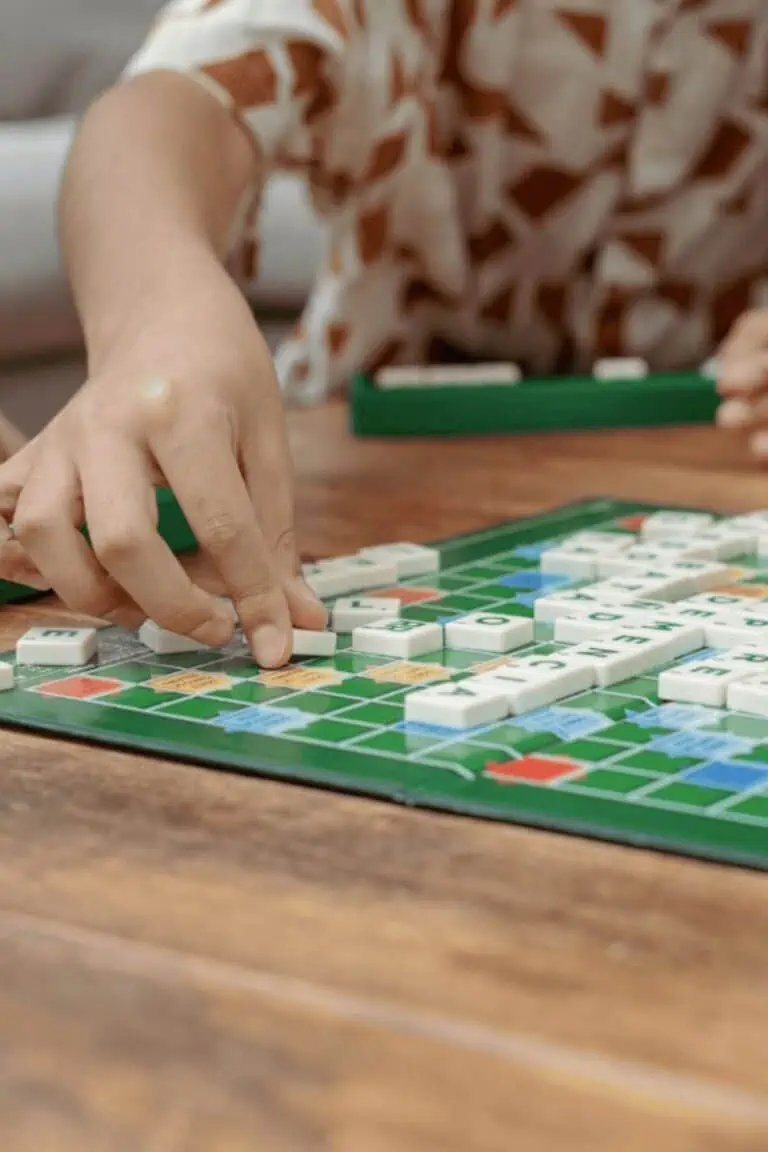
5 Letter Words That Start With B (FREE Word Search)
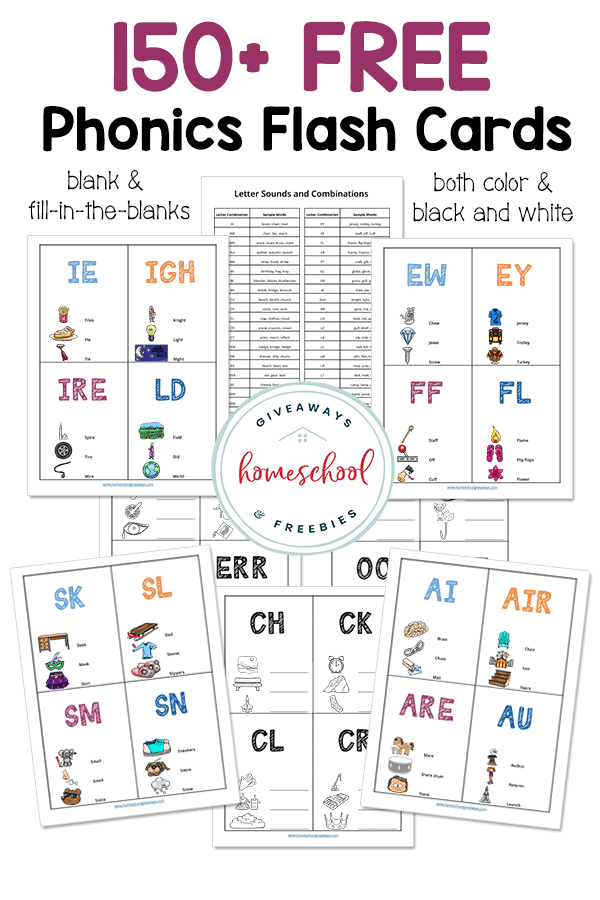
Free Printable Phonics Letter Sound Flashcards for Kids

Don’t Miss Anything! Subscribe to our newsletter to get the latest curriculum reviews and homeschool help. PLUS inspiring themes such as holidays, high school, unit studies, and more!
English/Lang Arts / History/Geography / Middle School
How to Write a Biography Report
Biographies are a great way to learn about history, music, art, science, and so much more! They are a window into not only a life, but I time period. They offer the chance to see the world through that person’s life, a would be first hand account of what life was like at that time. Reading biographies and learning how to write a biography report can be a fun and gentle approach to learning.
I remember a time with my oldest (who is now graduating from high school) that we used biographies as the core of our history learning. It allowed us to learn about time periods, movements, inventions, social roles, and so much more. Reading biographies and writing reports also worked with English/Language Arts skills such as spelling, vocabulary, grammar, punctuation. Plus, I remembering loving the more gentle, easy way of learning.
For this reason I am giving bibliographies another go around with my soon to be 5th grader. We will be Using the Who Was Biographies for our homeschool history. I created fun notebooking style biography sheets {You can get them for free here .) and plan to use them with a combination of timelines, photos, and free form writing to create a history notebook based on biographies.
Since we will be using biographies as our spine, I thought it would be good to compile a list of questions and things to consider when reading and then writing a biography report.
When writing a biography report, no matter who the person and what they have accomplished, there are certain things you want to be sure to touch on. Here is a list of questions and thoughts to get your child going with their report. These details will help them organize their thoughts and ensure they have covered the important topics in their biography report.
- Include a drawing of your character, the title of the biography, and the author of the biography.
- Tell the date and place where your character was born and raised.
- Describe the early life of your character. Things like where their grew up, their education, family, and jobs.
- Tell about what kind of person he or she was. What was it about your character that helped him or her to succeed? Did your character know what he or she wanted to become in the future? How did your character prepare for his or her future?
- Tell about the work your character did. Tell why his or her contribution was important, why the work was important. Did he or she invent something or teach others? How did he or she change the world? What lasting effects did your character have on the lives of others?
- What should we all know about your character? How do we benefit today from him or her? What do you think was the most impressive thing about your character?
- Tell how your character has inspired you. In what ways would you like to be him or her?
For many of these questions and more in worksheet form check out this FREE Biography Worksheet Printable
For a more in-depth look at writing a biography report (more of high school level and beyond) check out this article on How to Write a Biography
Related Posts
English/Lang Arts /
Online Vocabulary Program for Homeschoolers
History/Geography /
Online Homeschool American History for High School
Middle School /
Online Art Lessons for Kids with Sparketh
This really helped me a lot.
Leave a Reply
Your email address will not be published. Required fields are marked *
Save my name, email, and website in this browser for the next time I comment.
Learning Goals
- As you work on your biography presentation, use this rubric to help you do your best work.
Biography Presentation Rubric—Middle School
No Alignments yet.
Cite this work

How to Write a Biography
Biographies are big business. Whether in book form or Hollywood biopics, the lives of the famous and sometimes not-so-famous fascinate us.
While it’s true that most biographies are about people who are in the public eye, sometimes the subject is less well-known. Primarily, though, famous or not, the person who is written about has led an incredible life.
In this article, we will explain biography writing in detail for teachers and students so they can create their own.
While your students will most likely have a basic understanding of a biography, it’s worth taking a little time before they put pen to paper to tease out a crystal-clear definition of one.

What Is a Biography?

A biography is an account of someone’s life written by someone else . While there is a genre known as a fictional biography, for the most part, biographies are, by definition, nonfiction.
Generally speaking, biographies provide an account of the subject’s life from the earliest days of their childhood to the present day or their death if the subject is deceased.
The job of a biography is more than just to outline the bare facts of a person’s life.
Rather than just listing the basic details of their upbringing, hobbies, education, work, relationships, and death, a well-written biography should also paint a picture of the subject’s personality and experience of life.
A COMPLETE UNIT ON TEACHING BIOGRAPHIES

Teach your students to write AMAZING BIOGRAPHIES & AUTOBIOGRAPHIES using proven RESEARCH SKILLS and WRITING STRATEGIES .
- Understand the purpose of both forms of biography.
- Explore the language and perspective of both.
- Prompts and Challenges to engage students in writing a biography.
- Dedicated lessons for both forms of biography.
- Biographical Projects can expand students’ understanding of reading and writing a biography.
- A COMPLETE 82-PAGE UNIT – NO PREPARATION REQUIRED.
Features of a Biography
Before students begin writing a biography, they’ll need to have a firm grasp of the main features of Biography. An excellent way to determine how well they understand these essential elements is to ask them to compile a checklist like the one blow
At a minimum, their checklists should contain the items below. Be sure to help them fill in any gaps before moving on to the writing process.
The purpose of a biography is to provide an account of someone’s life.
Biography structure.
ORIENTATION (BEGINNING) Open your biography with a strong hook to grab the reader’s attention
SEQUENCING: In most cases, biographies are written in chronological order unless you are a very competent writer consciously trying to break from this trend.
COVER: childhood, upbringing, education, influences, accomplishments, relationships, etc. – everything that helps the reader to understand the person.
CONCLUSION: Wrap your biography up with some details about what the subject is doing now if they are still alive. If they have passed away, make mention of what impact they have made and what their legacy is or will be.
BIOGRAPHY FEATURES
LANGUAGE Use descriptive and figurative language that will paint images inside your audience’s minds as they read. Use time connectives to link events.
PERSPECTIVE Biographies are written from the third person’s perspective.
DETAILS: Give specific details about people, places, events, times, dates, etc. Reflect on how events shaped the subject. You might want to include some relevant photographs with captions. A timeline may also be of use depending upon your subject and what you are trying to convey to your audience.
TENSE Written in the past tense (though ending may shift to the present/future tense)
THE PROCESS OF WRITING A BIOGRAPHY
Like any form of writing, you will find it simple if you have a plan and follow it through. These steps will ensure you cover the essential bases of writing a biography essay.
Firstly, select a subject that inspires you. Someone whose life story resonates with you and whose contribution to society intrigues you. The next step is to conduct thorough research. Engage in extensive reading, explore various sources, watch documentaries, and glean all available information to provide a comprehensive account of the person’s life.
Creating an outline is essential to organize your thoughts and information. The outline should include the person’s early life, education, career, achievements, and any other significant events or contributions. It serves as a map for the writing process, ensuring that all vital information is included.
Your biography should have an engaging introduction that captivates the reader’s attention and provides background information on the person you’re writing about. It should include a thesis statement that summarizes the main points of the biography.
Writing a biography in chronological order is crucial . You should begin with the person’s early life and move through their career and achievements. This approach provides clarity on how the person’s life unfolded and how they accomplished their goals.
A biography should be written in a narrative style , capturing the essence of the person’s life through vivid descriptions, anecdotes, and quotes. Avoid dry, factual writing and focus on creating a compelling narrative that engages the reader.
Adding personal insights and opinions can enhance the biography’s overall impact, providing a unique perspective on the person’s achievements, legacy, and impact on society.
Editing and proofreading are vital elements of the writing process. Thoroughly reviewing your biography ensures that the writing is clear, concise, and error-free. You can even request feedback from someone else to ensure that it is engaging and well-written.
Finally, including a bibliography at the end of your biography is essential. It gives credit to the sources that were used during research, such as books, articles, interviews, and websites.
Tips for Writing a Brilliant Biography
Biography writing tip #1: choose your subject wisely.
There are several points for students to reflect on when deciding on a subject for their biography. Let’s take a look at the most essential points to consider when deciding on the subject for a biography:
Interest: To produce a biography will require sustained writing from the student. That’s why students must choose their subject well. After all, a biography is an account of someone’s entire life to date. Students must ensure they choose a subject that will sustain their interest throughout the research, writing, and editing processes.
Merit: Closely related to the previous point, students must consider whether the subject merits the reader’s interest. Aside from pure labors of love, writing should be undertaken with the reader in mind. While producing a biography demands sustained writing from the author, it also demands sustained reading from the reader.
Therefore, students should ask themselves if their chosen subject has had a life worthy of the reader’s interest and the time they’d need to invest in reading their biography.
Information: Is there enough information available on the subject to fuel the writing of an entire biography? While it might be a tempting idea to write about a great-great-grandfather’s experience in the war. There would be enough interest there to sustain the author’s and the reader’s interest, but do you have enough access to information about their early childhood to do the subject justice in the form of a biography?
Biography Writing Tip #2: R esearch ! Research! Research!
While the chances are good that the student already knows quite a bit about the subject they’ve chosen. Chances are 100% that they’ll still need to undertake considerable research to write their biography.
As with many types of writing , research is an essential part of the planning process that shouldn’t be overlooked. If a student wishes to give as complete an account of their subject’s life as possible, they’ll need to put in the time at the research stage.
An effective way to approach the research process is to:
1. Compile a chronological timeline of the central facts, dates, and events of the subject’s life
2. Compile detailed descriptions of the following personal traits:
- Physical looks
- Character traits
- Values and beliefs
3. Compile some research questions based on different topics to provide a focus for the research:
- Childhood : Where and when were they born? Who were their parents? Who were the other family members? What education did they receive?
- Obstacles: What challenges did they have to overcome? How did these challenges shape them as individuals?
- Legacy: What impact did this person have on the world and/or the people around them?
- Dialogue & Quotes: Dialogue and quotations by and about the subject are a great way to bring color and life to a biography. Students should keep an eagle eye out for the gems that hide amid their sources.
As the student gets deeper into their research, new questions will arise that can further fuel the research process and help to shape the direction the biography will ultimately go in.
Likewise, during the research, themes will often begin to suggest themselves. Exploring these themes is essential to bring depth to biography, but we’ll discuss this later in this article.
Research Skills:
Researching for biography writing is an excellent way for students to hone their research skills in general. Developing good research skills is essential for future academic success. Students will have opportunities to learn how to:
- Gather relevant information
- Evaluate different information sources
- Select suitable information
- Organize information into a text.
Students will have access to print and online information sources, and, in some cases, they may also have access to people who knew or know the subject (e.g. biography of a family member).
These days, much of the research will likely take place online. It’s crucial, therefore, to provide your students with guidance on how to use the internet safely and evaluate online sources for reliability. This is the era of ‘ fake news ’ and misinformation after all!
COMPLETE TEACHING UNIT ON INTERNET RESEARCH SKILLS USING GOOGLE SEARCH

Teach your students ESSENTIAL SKILLS OF THE INFORMATION ERA to become expert DIGITAL RESEARCHERS.
⭐How to correctly ask questions to search engines on all devices.
⭐ How to filter and refine your results to find exactly what you want every time.
⭐ Essential Research and critical thinking skills for students.
⭐ Plagiarism, Citing and acknowledging other people’s work.
⭐ How to query, synthesize and record your findings logically.
BIOGRAPHY WRITING Tip #3: Find Your Themes In Biography Writing
Though predominantly a nonfiction genre, the story still plays a significant role in good biography writing. The skills of characterization and plot structuring are transferable here. And, just like in fiction, exploring themes in a biographical work helps connect the personal to the universal. Of course, these shouldn’t be forced; this will make the work seem contrived, and the reader may lose faith in the truthfulness of the account. A biographer needs to gain and maintain the trust of the reader.
Fortunately, themes shouldn’t need to be forced. A life well-lived is full of meaning, and the themes the student writer is looking for will emerge effortlessly from the actions and events of the subject’s life. It’s just a case of learning how to spot them.
One way to identify the themes in a life is to look for recurring events or situations in a person’s life. These should be apparent from the research completed previously. The students should seek to identify these patterns that emerge in the subject’s life. For example, perhaps they’ve had to overcome various obstacles throughout different periods of their life. In that case, the theme of overcoming adversity is present and has been identified.
Usually, a biography has several themes running throughout, so be sure your students work to identify more than one theme in their subject’s life.
BIOGRAPHY WRITING Tip: #4 Put Something of Yourself into the Writing
While the defining feature of a biography is that it gives an account of a person’s life, students must understand that this is not all a biography does. Relating the facts and details of a subject’s life is not enough. The student biographer should not be afraid to share their thoughts and feelings with the reader throughout their account of their subject’s life.
The student can weave some of their personality into the fabric of the text by providing commentary and opinion as they relate the events of the person’s life and the wider social context at the time. Unlike the detached and objective approach we’d expect to find in a history textbook, in a biography, student-writers should communicate their enthusiasm for their subject in their writing.
This makes for a more intimate experience for the reader, as they get a sense of getting to know the author and the subject they are writing about.
Student Examples of Biography Writing
- Year 5 Example
- Year 7 Example
- Year 9 Example
“The Rock ‘n’ Roll King: Elvis Presley”
Elvis Aaron Presley, born on January 8, 1935, was an amazing singer and actor known as the “King of Rock ‘n’ Roll.” Even though he’s been dead for nearly 50 years, I can’t help but be fascinated by his incredible life!
Elvis grew up in Tupelo, Mississippi, in a tiny house with his parents and twin brother. His family didn’t have much money, but they shared a love for music. Little did they know Elvis would become a music legend!
When he was only 11 years old, Elvis got his first guitar. He taught himself to play and loved singing gospel songs. As he got older, he started combining different music styles like country, blues, and gospel to create a whole new sound – that’s Rock ‘n’ Roll!
In 1954, at the age of 19, Elvis recorded his first song, “That’s All Right.” People couldn’t believe how unique and exciting his music was. His famous hip-swinging dance moves also made him a sensation!
Elvis didn’t just rock the music scene; he also starred in movies like “Love Me Tender” and “Jailhouse Rock.” But fame came with challenges. Despite facing ups and downs, Elvis kept spreading happiness through his music.

Tragically, Elvis passed away in 1977, but his music and charisma live on. Even today, people worldwide still enjoy his songs like “Hound Dog” and “Can’t Help Falling in Love.” Elvis Presley’s legacy as the King of Rock ‘n’ Roll will live forever.
Long Live the King: I wish I’d seen him.
Elvis Presley, the Rock ‘n’ Roll legend born on January 8, 1935, is a captivating figure that even a modern-day teen like me can’t help but admire. As I delve into his life, I wish I could have experienced the magic of his live performances.
Growing up in Tupelo, Mississippi, Elvis faced challenges but found solace in music. At 11, he got his first guitar, a symbol of his journey into the world of sound. His fusion of gospel, country, and blues into Rock ‘n’ Roll became a cultural phenomenon.
The thought of being in the audience during his early performances, especially when he recorded “That’s All Right” at 19, sends shivers down my spine. Imagining the crowd’s uproar and feeling the revolutionary energy of that moment is a dream I wish I could have lived.
Elvis wasn’t just a musical prodigy; he was a dynamic performer. His dance moves, the embodiment of rebellion, and his roles in films like “Love Me Tender” and “Jailhouse Rock” made him a true icon.
After watching him on YouTube, I can’t help but feel a little sad that I’ll never witness the King’s live performances. The idea of swaying to “Hound Dog” or being enchanted by “Can’t Help Falling in Love” in person is a missed opportunity. Elvis may have left us in 1977, but he was the king of rock n’ roll. Long live the King!
Elvis Presley: A Teen’s Take on the Rock ‘n’ Roll Icon”
Elvis Presley, born January 8, 1935, was a revolutionary force in the music world, earning his title as the “King of Rock ‘n’ Roll.” Exploring his life, even as a 16-year-old today, I’m captivated by the impact he made.
Hailing from Tupelo, Mississippi, Elvis grew up in humble beginnings, surrounded by the love of his parents and twin brother. It’s inspiring to think that, despite financial challenges, this young man would redefine the music scene.
At 11, Elvis got his first guitar, sparking a self-taught journey into music. His early gospel influences evolved into a unique fusion of country, blues, and gospel, creating the electrifying genre of Rock ‘n’ Roll. In 1954, at only 19, he recorded “That’s All Right,” marking the birth of a musical legend.
Elvis wasn’t just a musical innovator; he was a cultural phenomenon. His rebellious dance moves and magnetic stage presence challenged the norms. He transitioned seamlessly into acting, starring in iconic films like “Love Me Tender” and “Jailhouse Rock.”

However, fame came at a cost, and Elvis faced personal struggles. Despite the challenges, his music continued to resonate. Even now, classics like “Hound Dog” and “Can’t Help Falling in Love” transcend generations.
Elvis Presley’s impact on music and culture is undeniable. He was known for his unique voice, charismatic persona, and electrifying performances. He sold over one billion records worldwide, making him one of the best-selling solo artists in history. He received numerous awards throughout his career, including three Grammy Awards and the Grammy Lifetime Achievement Award.
Elvis’s influence can still be seen in today’s music. Many contemporary artists, such as Bruno Mars, Lady Gaga, and Justin Timberlake, have cited Elvis as an inspiration. His music continues to be featured in movies, TV shows, and commercials.
Elvis left us in 1977, but his legacy lives on. I appreciate his breaking barriers and fearlessly embracing his artistic vision. Elvis Presley’s impact on music and culture is timeless, a testament to the enduring power of his artistry. His music has inspired generations and will continue to do so for many years to come.

Teaching Resources
Use our resources and tools to improve your student’s writing skills through proven teaching strategies.
BIOGRAPHY WRITING TEACHING IDEAS AND LESSONS
We have compiled a sequence of biography-related lessons or teaching ideas that you can follow as you please. They are straightforward enough for most students to follow without further instruction.
BIOGRAPHY LESSON IDEA # 1:
This session aims to give students a broader understanding of what makes a good biography.
Once your students have compiled a comprehensive checklist of the main features of a biography, allow them to use it to assess some biographies from your school library or on the internet using the feature checklist.
When students have assessed a selection of biographies, take some time as a class to discuss them. You can base the discussion around the following prompts:
- Which biographies covered all the criteria from their checklist?
- Which biographies didn’t?
- Which biography was the most readable in terms of structure?
- Which biography do you think was the least well-structured? How would you improve this?
Looking at how other writers have interpreted the form will help students internalize the necessary criteria before attempting to produce a biography. Once students have a clear understanding of the main features of the biography, they’re ready to begin work on writing a biography.
When the time does come to put pen to paper, be sure they’re armed with the following top tips to help ensure they’re as well prepared as possible.
BIOGRAPHY LESSON IDEA # 2:
This session aims to guide students through the process of selecting the perfect biography subject.
Instruct students to draw up a shortlist of three potential subjects for the biography they’ll write.
Using the three criteria mentioned in the writing guide (Interest, Merit, and Information), students award each potential subject a mark out of 5 for each of the criteria. In this manner, students can select the most suitable subject for their biography.
BIOGRAPHY LESSON IDEA # 3:
This session aims to get students into the researching phase and then prioritise events and organise them chronologically.
Students begin by making a timeline of their subject’s life, starting with their birth and ending with their death or the present day. If the student has yet to make a final decision on the subject of their biography, a family member will often serve well for this exercise as a practice exercise.
Students should research and gather the key events of the person’s life, covering each period of their life from when they were a baby, through childhood and adolescence, right up to adulthood and old age. They should then organize these onto a timeline. Students can include photographs with captions if they have them.
They can present these to the class when they have finished their timelines.
BIOGRAPHY LESSON IDEA # 4:
Instruct students to look over their timeline, notes, and other research. Challenge them to identify three patterns that repeat throughout the subject’s life and sort all the related events and incidents into specific categories.
Students should then label each category with a single word. This is the thematic concept or the broad general underlying idea. After that, students should write a sentence or two expressing what the subject’s life ‘says’ about that concept.
This is known as the thematic statement . With the thematic concepts and thematic statements identified, the student now has some substantial ideas to explore that will help bring more profound meaning and wider resonance to their biography.
BIOGRAPHY LESSON IDEA # 5:
Instruct students to write a short objective account of an event in their own life. They can write about anyone from their past. It needn’t be more than a couple of paragraphs, but the writing should be strictly factual, focusing only on the objective details of what happened.
Once they have completed this, it’s time to rewrite the paragraph, but they should include some opinion and personal commentary this time.
The student here aims to inject some color and personality into their writing, to transform a detached, factual account into a warm, engaging story.

Get our FREE Biography Writing Graphic Organizer
Use this valuable tool in the research and writing phases to keep your students on track and engaged.
WRITING CHECKLIST & RUBRIC BUNDLE

To Conclude
By this stage, your students should have an excellent technical overview of a biography’s essential elements.
They should be able to choose their subject in light of how interesting and worthy they are, as well as give consideration to the availability of information out there. They should be able to research effectively and identify emerging themes in their research notes. And finally, they should be able to bring some of their personality and uniqueness into their retelling of the life of another.
Remember that writing a biography is not only a great way to develop a student’s writing skills; it can be used in almost all curriculum areas. For example, to find out more about a historical figure in History, to investigate scientific contributions to Science, or to celebrate a hero from everyday life.
Biography is an excellent genre for students to develop their writing skills and to find inspiration in the lives of others in the world around them.
HOW TO WRITE A BIOGRAPHY TUTORIAL VIDEO

OTHER GREAT ARTICLES RELATED TO BIOGRAPHY WRITING

How to write an Autobiography

How to Write a Historical Recount Text

15 Awesome Recount & Personal Narrative Topics

Personal Narrative Writing Guide

How to Write a Book Report
Use the links below to jump directly to any section of this guide:
Book Report Fundamentals
Preparing to write, an overview of the book report format, how to write the main body of a book report, how to write a conclusion to a book report, reading comprehension and book reports, book report resources for teachers .
Book reports remain a key educational assessment tool from elementary school through college. Sitting down to close read and critique texts for their content and form is a lifelong skill, one that benefits all of us well beyond our school years. With the help of this guide, you’ll develop your reading comprehension and note-taking skills. You’ll also find resources to guide you through the process of writing a book report, step-by-step, from choosing a book and reading actively to revising your work. Resources for teachers are also included, from creative assignment ideas to sample rubrics.
Book reports follow general rules for composition, yet are distinct from other types of writing assignments. Central to book reports are plot summaries, analyses of characters and themes, and concluding opinions. This format differs from an argumentative essay or critical research paper, in which impartiality and objectivity is encouraged. Differences also exist between book reports and book reviews, who do not share the same intent and audience. Here, you’ll learn the basics of what a book report is and is not.
What Is a Book Report?
"Book Report" ( ThoughtCo )
This article, written by a professor emeritus of rhetoric and English, describes the defining characteristics of book reports and offers observations on how they are composed.
"Writing a Book Report" (Purdue OWL)
Purdue’s Online Writing Lab outlines the steps in writing a book report, from keeping track of major characters as you read to providing adequate summary material.
"How to Write a Book Report" ( Your Dictionary )
This article provides another helpful guide to writing a book report, offering suggestions on taking notes and writing an outline before drafting.
"How to Write a Successful Book Report" ( ThoughtCo )
Another post from ThoughtCo., this article highlights the ten steps for book report success. It was written by an academic advisor and college enrollment counselor.
What’s the Difference Between a Book Report and an Essay?
"Differences Between a Book Report & Essay Writing" ( Classroom)
In this article from the education resource Classroom, you'll learn the differences and similarities between book reports and essay writing.
"Differences Between a Book Report and Essay Writing" (SeattlePi.com)
In this post from a Seattle newspaper's website, memoirist Christopher Cascio highlights how book report and essay writing differ.
"The Difference Between Essays and Reports" (Solent Online Learning)
This PDF from Southampton Solent University includes a chart demonstrating the differences between essays and reports. Though it is geared toward university students, it will help students of all levels understand the differing purposes of reports and analytical essays.
What’s the Difference Between a Book Report and a Book Review?
"How to Write a Book Review and a Book Report" (Concordia Univ.)
The library at Concordia University offers this helpful guide to writing book report and book reviews. It defines differences between the two, then presents components that both forms share.
"Book Reviews" (Univ. of North Carolina)
The University of North Carolina at Chapel Hill’s writing guide shows the step-by-step process of writing book reviews, offering a contrast to the composition of book reports.
Active reading and thoughtful preparation before you begin your book report are necessary components of crafting a successful piece of writing. Here, you’ll find tips and resources to help you learn how to select the right book, decide which format is best for your report, and outline your main points.
Selecting and Finding a Book
"30 Best Books for Elementary Readers" (Education.com)
This article from Education.com lists 30 engaging books for students from kindergarten through fifth grade. It was written by Esme Raji Codell, a teacher, author, and children's literature specialist.
"How to Choose a Good Book for a Report (Middle School)" (WikiHow)
This WikiHow article offers suggestions for middle schoolers on how to choose the right book for a report, from getting started early on the search process to making sure you understand the assignment's requirements.
"Best Book-Report Books for Middle Schoolers" (Common Sense Media)
Common Sense Media has compiled this list of 25 of the best books for middle school book reports. For younger students, the article suggests you check out the site's "50 Books All Kids Should Read Before They're 12."
"50 Books to Read in High School" (Lexington Public Library)
The Lexington, Kentucky Public Library has prepared this list to inspire high school students to choose the right book. It includes both classics and more modern favorites.
The Online Computer Library Center's catalogue helps you locate books in libraries near you, having itemized the collections of 72,000 libraries in 170 countries.
Formats of Book Reports
"Format for Writing a Book Report" ( Your Dictionary )
Here, Your Dictionary supplies guidelines for the basic book report format. It describes what you'll want to include in the heading, and what information to include in the introductory paragraph. Be sure to check these guidelines against your teacher's requirements.
"The Good Old Book Report" (Scholastic)
Nancy Barile’s blog post for Scholastic lists the questions students from middle through high school should address in their book reports.
How to Write an Outline
"Writer’s Web: Creating Outlines" (Univ. of Richmond)
The University of Richmond’s Writing Center shows how you can make use of micro and macro outlines to organize your argument.
"Why and How to Create a Useful Outline" (Purdue OWL)
Purdue’s Online Writing Lab demonstrates how outlines can help you organize your report, then teaches you how to create outlines.
"Creating an Outline" (EasyBib)
EasyBib, a website that generates bibliographies, offers sample outlines and tips for creating your own. The article encourages you to think about transitions and grouping your notes.
"How to Write an Outline: 4 Ways to Organize Your Thoughts" (Grammarly)
This blog post from a professional writer explains the advantages of using an outline, and presents different ways to gather your thoughts before writing.
In this section, you’ll find resources that offer an overview of how to write a book report, including first steps in preparing the introduction. A good book report's introduction hooks the reader with strong opening sentences and provides a preview of where the report is going.
"Step-by-Step Outline for a Book Report" ( Classroom )
This article from Classroom furnishes students with a guide to the stages of writing a book report, from writing the rough draft to revising.
"Your Roadmap to a Better Book Report" ( Time4Writing )
Time4Writing offers tips for outlining your book report, and describes all of the information that the introduction, body, and conclusion should include.
"How to Start a Book Report" ( ThoughtCo)
This ThoughtCo. post, another by academic advisor and college enrollment counselor Grace Fleming, demonstrates how to write a pithy introduction to your book report.
"How to Write an Introduction for a Book Report" ( Classroom )
This brief but helpful post from Classroom details what makes a good book report introduction, down to the level of individual sentences.
The body paragraphs of your book report accomplish several goals: they describe the plot, delve more deeply into the characters and themes that make the book unique, and include quotations and examples from the book. Below are some resources to help you succeed in summarizing and analyzing your chosen text.
Plot Summary and Description
"How Do You Write a Plot Summary?" ( Reference )
This short article presents the goals of writing a plot summary, and suggests a word limit. It emphasizes that you should stick to the main points and avoid including too many specific details, such as what a particular character wears.
"How to Write a Plot for a Book Report" ( The Pen & The Pad )
In this article from a resource website for writers, Patricia Harrelson outlines what information to include in a plot summary for a book report.
"How to Write a Book Summary" (WikiHow)
Using Harry Potter and the Sorcerer’s Stone as an example, this WikiHow article demonstrates how to write a plot summary one step at a time.
Analyzing Characters and Themes
"How to Write a Character Analysis Book Report" ( The Pen & The Pad )
Kristine Tucker shows how to write a book report focusing on character. You can take her suggestions as they are, or consider incorporating them into the more traditional book report format.
"How to Write a Character Analysis" (YouTube)
The SixMinuteScholar Channel utilizes analysis of the film Finding Nemo to show you how to delve deeply into character, prioritizing inference over judgment.
"How to Define Theme" ( The Editor's Blog )
Fiction editor Beth Hill contributes an extended definition of theme. She also provides examples of common themes, such as "life is fragile."
"How to Find the Theme of a Book or Short Story" ( ThoughtCo )
This blog post from ThoughtCo. clarifies the definition of theme in relation to symbolism, plot, and moral. It also offers examples of themes in literature, such as love, death, and good vs. evil.
Selecting and Integrating Quotations
"How to Choose and Use Quotations" (Santa Barbara City College)
This guide from a college writing center will help you choose which quotations to use in your book report, and how to blend quotations with your own words.
"Guidelines for Incorporating Quotes" (Ashford Univ.)
This PDF from Ashford University's Writing Center introduces the ICE method for incorporating quotations: introduce, cite, explain.
"Quote Integration" (YouTube)
This video from The Write Way YouTube channel illustrates how to integrate quotations into writing, and also explains how to cite those quotations.
"Using Literary Quotations" (Univ. of Wisconsin-Madison)
This guide from the University of Wisconsin-Madison’s Writing Center helps you emphasize your analysis of a quotation, and explains how to incorporate quotations into your text.
Conclusions to any type of paper are notoriously tricky to write. Here, you’ll learn some creative ways to tie up loose ends in your report and express your own opinion of the book you read. This open space for sharing opinions that are not grounded in critical research is an element that often distinguishes book reports from other types of writing.
"How to Write a Conclusion for a Book Report" ( Classroom )
This brief article from the education resource Classroom illustrates the essential points you should make in a book report conclusion.
"Conclusions" (Univ. of North Carolina)
The University of North Carolina at Chapel Hill’s Writing Center lays out strategies for writing effective conclusions. Though the article is geared toward analytical essay conclusions, the tips offered here will also help you write a strong book report.
"Ending the Essay: Conclusions" (Harvard College Writing Center)
Pat Bellanca’s article for Harvard University’s Writing Center presents ways to conclude essays, along with tips. Again, these are suggestions for concluding analytical essays that can also be used to tie up a book report's loose ends.
Reading closely and in an engaged manner is the strong foundation upon which all good book reports are built. The resources below will give you a picture of what active reading looks like, and offer strategies to assess and improve your reading comprehension. Further, you’ll learn how to take notes—or “annotate” your text—making it easier to find important information as you write.
How to Be an Active Reader
"Active Reading Strategies: Remember and Analyze What You Read" (Princeton Univ.)
Princeton University’s McGraw Center for Teaching and Learning recommends ten strategies for active reading, and includes sample diagrams.
"Active Reading" (Open Univ.)
The Open University offers these techniques for reading actively alongside video examples. The author emphasizes that you should read for comprehension—not simply to finish the book as quickly as possible.
"7 Active Reading Strategies for Students" ( ThoughtCo )
In this post, Grace Fleming outlines seven methods for active reading. Her suggestions include identifying unfamiliar words and finding the main idea.
"5 Active Reading Strategies for Textbook Assignments" (YouTube)
Thomas Frank’s seven-minute video demonstrates how you can retain the most important information from long and dense reading material.
Assessing Your Reading Comprehension
"Macmillan Readers Level Test" (MacMillan)
Take this online, interactive test from a publishing company to find out your reading level. You'll be asked a number of questions related to grammar and vocabulary.
"Reading Comprehension Practice Test" (ACCUPLACER)
ACCUPLACER is a placement test from The College Board. This 20-question practice test will help you see what information you retain after reading short passages.
"Reading Comprehension" ( English Maven )
The English Maven site has aggregated exercises and tests at various reading levels so you can quiz your reading comprehension skills.
How to Improve Your Reading Comprehension
"5 Tips for Improving Reading Comprehension" ( ThoughtCo )
ThoughtCo. recommends five tips to increase your reading comprehension ability, including reading with tools such as highlighters, and developing new vocabulary.
"How to Improve Reading Comprehension: 8 Expert Tips" (PrepScholar)
This blog post from PrepScholar provides ideas for improving your reading comprehension, from expanding your vocabulary to discussing texts with friends.
CrashCourse video: "Reading Assignments" (YouTube)
This CrashCourse video equips you with tools to read more effectively. It will help you determine how much material you need to read, and what strategies you can use to absorb what you read.
"Improving Reading Comprehension" ( Education Corner )
From a pre-reading survey through post-reading review, Education Corner walks you through steps to improve reading comprehension.
Methods of In-text Annotation
"The Writing Process: Annotating a Text" (Hunter College)
This article from Hunter College’s Rockowitz Writing Center outlines how to take notes on a text and provides samples of annotation.
"How To Annotate Text While Reading" (YouTube)
This video from the SchoolHabits YouTube channel presents eleven annotation techniques you can use for better reading comprehension.
"5 Ways To Annotate Your Books" ( Book Riot )
This article from the Book Riot blog highlights five efficient annotation methods that will save you time and protect your books from becoming cluttered with unnecessary markings.
"How Do You Annotate Your Books?" ( Epic Reads )
This post from Epic Reads highlights how different annotation methods work for different people, and showcases classic methods from sticky notes to keeping a reading notebook.
Students at every grade level can benefit from writing book reports, which sharpen critical reading skills. Here, we've aggregated sources to help you plan book report assignments and develop rubrics for written and oral book reports. You’ll also find alternative book report assessment ideas that move beyond the traditional formats.
Teaching Elementary School Students How to Write Book Reports
"Book Reports" ( Unique Teaching Resources )
These reading templates courtesy of Unique Teaching Resources make great visual aids for elementary school students writing their first book reports.
"Elementary Level Book Report Template" ( Teach Beside Me )
This printable book report template from a teacher-turned-homeschooler is simple, classic, and effective. It asks basic questions, such as "who are the main characters?" and "how did you feel about the main characters?"
"Book Reports" ( ABC Teach )
ABC Teach ’s resource directory includes printables for book reports on various subjects at different grade levels, such as a middle school biography book report form and a "retelling a story" elementary book report template.
"Reading Worksheets" ( Busy Teacher's Cafe )
This page from Busy Teachers’ Cafe contains book report templates alongside reading comprehension and other language arts worksheets.
Teaching Middle School and High School Students How to Write Book Reports
"How to Write a Book Report: Middle and High School Level" ( Fact Monster)
Fact Monster ’s Homework Center discusses each section of a book report, and explains how to evaluate and analyze books based on genre for students in middle and high school.
"Middle School Outline Template for Book Report" (Trinity Catholic School)
This PDF outline template breaks the book report down into manageable sections for seventh and eighth graders by asking for specific information in each paragraph.
"Forms for Writing a Book Report for High School" ( Classroom )
In this article for Classroom, Elizabeth Thomas describes what content high schoolers should focus on when writing their book reports.
"Forms for Writing a Book Report for High School" ( The Pen & The Pad )
Kori Morgan outlines techniques for adapting the book report assignment to the high school level in this post for The Pen & The Pad .
"High School Book Lists and Report Guidelines" (Highland Hall Waldorf School)
These sample report formats, grading paradigms, and tips are collected by Highland Hall Waldorf School. Attached are book lists by high school grade level.
Sample Rubrics
"Book Review Rubric Editable" (Teachers Pay Teachers)
This free resource from Teachers Pay Teachers allows you to edit your book report rubric to the specifications of your assignment and the grade level you teach.
"Book Review Rubric" (Winton Woods)
This PDF rubric from a city school district includes directions to take the assignment long-term, with follow-up exercises through school quarters.
"Multimedia Book Report Rubric" ( Midlink Magazine )
Perfect for oral book reports, this PDF rubric from North Carolina State University's Midlink Magazine will help you evaluate your students’ spoken presentations.
Creative Book Report Assignments
"25 Book Report Alternatives" (Scholastic)
This article from the Scholastic website lists creative alternatives to the standard book report for pre-kindergarteners through high schoolers.
"Fresh Ideas for Creative Book Reports" ( Education World )
Education World offers nearly 50 alternative book report ideas in this article, from a book report sandwich to a character trait diagram.
"A Dozen Ways to Make Amazingly Creative Book Reports" ( We Are Teachers )
This post from We Are Teachers puts the spotlight on integrating visual arts into literary study through multimedia book report ideas.
"More Ideas Than You’ll Ever Use for Book Reports" (Teachnet.com)
This list from Teachnet.com includes over 300 ideas for book report assignments, from "interviewing" a character to preparing a travel brochure to the location in which the book is set.
"Fifty Alternatives to the Book Report" (National Council of Teachers of English)
In this PDF resource from the NCTE's English Journal, Diana Mitchell offers assignment ideas ranging from character astrology signs to a character alphabet.
- PDFs for all 136 Lit Terms we cover
- Downloads of 1908 LitCharts Lit Guides
- Teacher Editions for every Lit Guide
- Explanations and citation info for 40,181 quotes across 1908 books
- Downloadable (PDF) line-by-line translations of every Shakespeare play
Need something? Request a new guide .
How can we improve? Share feedback .
LitCharts is hiring!

Biography Book Report Template
Description
Streamline your book report writing with our pre-made template! Cover all the crucial aspects of the book including plot summary, character analysis, and personal opinions. A must-have resource for efficient and effective reporting.
Terms of use apply.
Open with Kami to
Add text, images and videos
Leave interactive annotations
Collaborate in real-time
Assign to students
Edit in offline mode
Related Templates
Newspaper Template
Introduce your students to the world of journalism with this newspaper template. It can be used as a starting point for writing about current events or for publishing their own articles.
Handwriting Template | Dashed Lines Landscape
This blank handwriting template is perfect for practicing your writing skills!
Story Sequencing Activity
Uncover the story's sequence with our easy and fun activity!
The Space Times - Interactive Reading Activity (Primary)
This interactive reading activity takes your students on an out-of-this-world journey. Help our Captain return safely to Planet Luna while learning new vocabulary and writing your own ending for the story.
Explore Kami Library
Tap the on any templates you'd like to mix and match as a new file, totally free.
Download any templates for your K-12 classroom
Ready-to-use
100% accessible, no sign-in needed
Kami-compatible
Use Kami to personalize, assign and grade
False report of someone with shotgun prompts lockout at three Brighton school buildings

Brighton, N.Y. — Police said a report of someone with a shotgun, which they now believe may have been an umbrella, prompted a lockout in three Brighton Central School District buildings Thursday.
Officers responded to Brighton High School after a passing driver reported seeing someone with what appeared to be a shotgun.
Police ordered Brighton's high school, middle school and central offices to go into lockout as a precaution due to a "potential threat off campus," according to the district.
The district reported the lockout — which prevented anyone from entering or exiting the buildings — to the public at 1:28 p.m.
Police said after re-interviewing the caller, they believe the object may have been an umbrella.
We encourage people when they "see something to say something" and this is a good example of that.
The district reported at 1:57 p.m. that the lockout was lifted after police determined there was "no credible threat,"
Read our research on: Gun Policy | International Conflict | Election 2024
Regions & Countries
What’s it like to be a teacher in america today, public k-12 teachers are stressed about their jobs and few are optimistic about the future of education; many say poverty, absenteeism and mental health are major problems at their school.
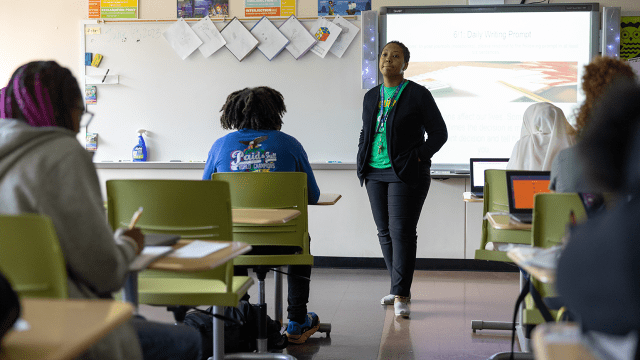
Pew Research Center conducted this study to better understand the views and experiences of public K-12 school teachers. The analysis in this report is based on an online survey of 2,531 U.S. public K-12 teachers conducted from Oct. 17 to Nov. 14, 2023. The teachers surveyed are members of RAND’s American Teacher Panel, a nationally representative panel of public K-12 school teachers recruited through MDR Education. Survey data is weighted to state and national teacher characteristics to account for differences in sampling and response to ensure they are representative of the target population.
Here are the questions used for this report , along with responses, and the survey methodology .
Low-poverty , medium-poverty and high-poverty schools are based on the percentage of students eligible for free and reduced-price lunch, as reported by the National Center for Education Statistics (less than 40%, 40%-59% and 60% or more, respectively).
Secondary schools include both middle schools and high schools.
All references to party affiliation include those who lean toward that party. Republicans include those who identify as Republicans and those who say they lean toward the Republican Party. Democrats include those who identify as Democrats and those who say they lean toward the Democratic Party.
Public K-12 schools in the United States face a host of challenges these days – from teacher shortages to the lingering effects of COVID-19 learning loss to political battles over curriculum .
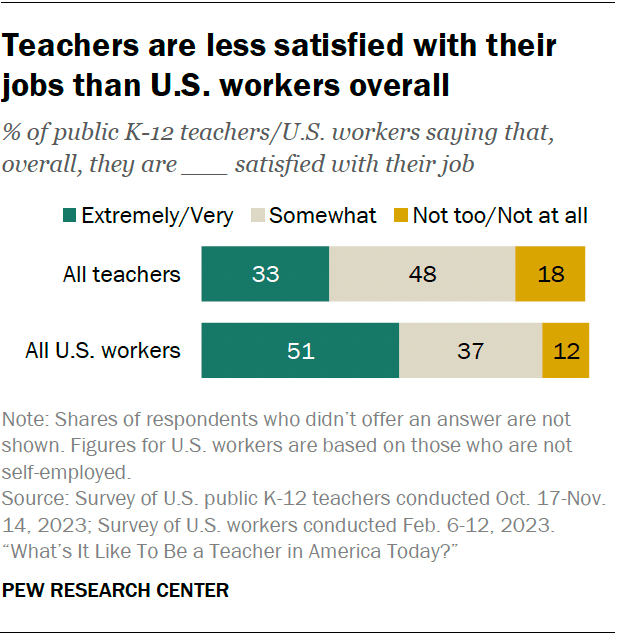
In the midst of all this, teachers express low levels of satisfaction with their jobs. In fact, they’re much less satisfied than U.S. workers overall.
Here’s how public K-12 teachers are feeling about their jobs:
- 77% say their job is frequently stressful.
- 68% say it’s overwhelming.
- 70% say their school is understaffed.
- 52% say they would not advise a young person starting out today to become a teacher.
When it comes to how their students are doing in school, teachers are relatively downbeat about both academic performance and behavior.
Here’s how public K-12 teachers rate academic performance and behavior at their school:
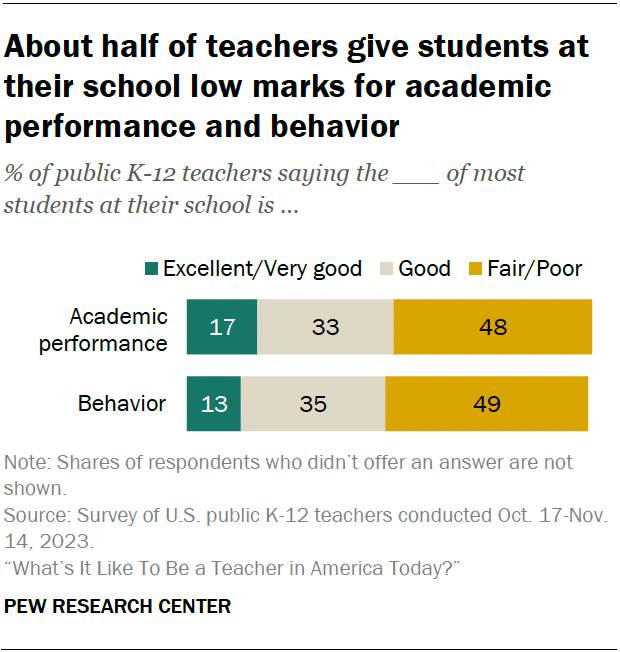
- 48% say the academic performance of most students at their school is fair or poor. A third say it’s good, and only 17% describe it as excellent or very good.
- 49% say the behavior of most students at their school is fair or poor; 35% say it’s good and 13% say it’s excellent or very good.
The COVID-19 pandemic likely compounded these issues. About eight-in-ten teachers (among those who have been teaching for at least a year) say the lasting impact of the pandemic on students’ behavior, academic performance and emotional well-being has been very or somewhat negative.
Assessments of student performance and behavior differ widely by school poverty level. 1 Teachers in high-poverty schools have a much more negative outlook. But feelings of stress and dissatisfaction among teachers are fairly universal, regardless of where they teach.
Related: What Public K-12 Teachers Want Americans To Know About Teaching
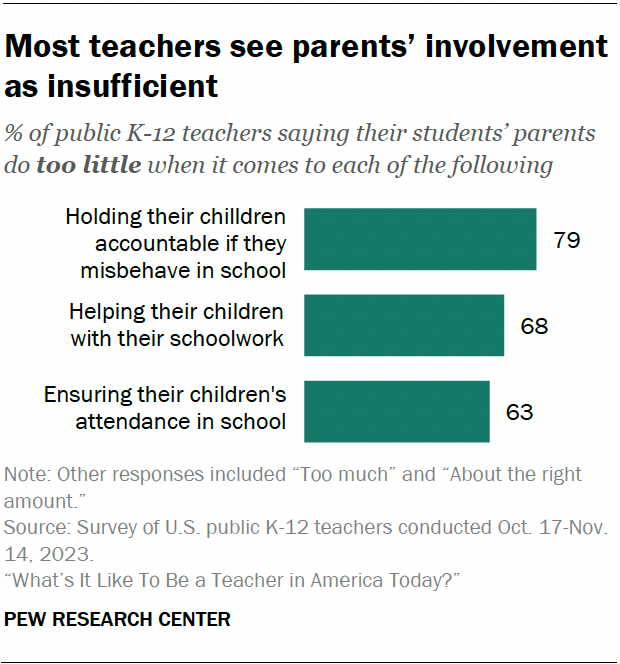
As they navigate these challenges, teachers don’t feel they’re getting the support or reinforcement they need from parents.
Majorities of teachers say parents are doing too little when it comes to holding their children accountable if they misbehave in school, helping them with their schoolwork and ensuring their attendance.
Teachers in high- and medium-poverty schools are more likely than those in low-poverty schools to say parents are doing too little in each of these areas.
These findings are based on a survey of 2,531 U.S. public K-12 teachers conducted Oct. 17-Nov. 14, 2023, using the RAND American Teacher Panel. 2 The survey looks at the following aspects of teachers’ experiences:
- Teachers’ job satisfaction (Chapter 1)
- How teachers manage their workload (Chapter 2)
- Problems students are facing at public K-12 schools (Chapter 3)
- Challenges in the classroom (Chapter 4)
- Teachers’ views of parent involvement (Chapter 5)
- Teachers’ views on the state of public K-12 education (Chapter 6)
Problems students are facing
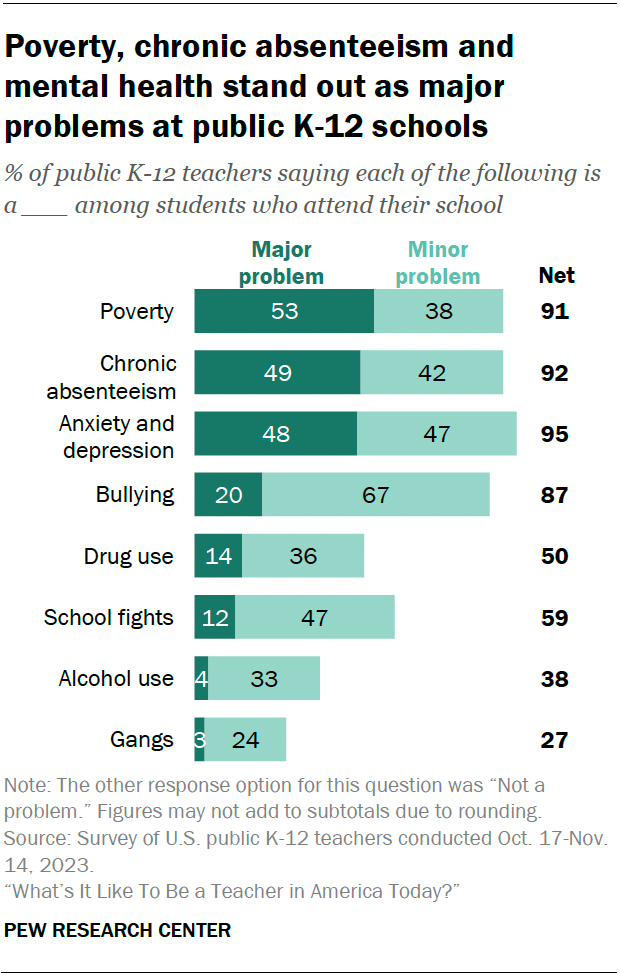
We asked teachers about some of the challenges students at their school are facing. Three problems topped the list:
- Poverty (53% say this is a major problem among students who attend their school)
- Chronic absenteeism (49%)
- Anxiety and depression (48%)
Chronic absenteeism (that is, students missing a substantial number of school days) is a particular challenge at high schools, with 61% of high school teachers saying this is a major problem where they teach. By comparison, 46% of middle school teachers and 43% of elementary school teachers say the same.
Anxiety and depression are viewed as a more serious problem at the secondary school level: 69% of high school teachers and 57% of middle school teachers say this is a major problem among their students, compared with 29% of elementary school teachers.
Fewer teachers (20%) view bullying as a major problem at their school, though the share is significantly higher among middle school teachers (34%).
A look inside the classroom
We also asked teachers how things are going in their classroom and specifically about some of the issues that may get in the way of teaching.
- 47% of teachers say students showing little or no interest in learning is a major problem in their classroom. The share rises to 58% among high school teachers.
- 33% say students being distracted by their cellphones is a major problem. This is particularly an issue for high school teachers, with 72% saying this is a major problem.
- About one-in-five teachers say students getting up and walking around when they’re not supposed to and being disrespectful toward them (21% each) are major problems. Teachers in elementary and middle schools are more likely than those in high schools to see these as challenges.
A majority of teachers (68%) say they’ve experienced verbal abuse from a student – such as being yelled at or threatened. Some 21% say this happens at least a few times a month.
Physical violence is less common. Even so, 40% of teachers say a student has been violent toward them , with 9% saying this happens at least a few times a month.
About two-thirds of teachers (66%) say that the current discipline practices at their school are very or somewhat mild. Only 2% say the discipline practices at their school are very or somewhat harsh, while 31% say they are neither harsh nor mild. Most teachers (67%) say teachers themselves don’t have enough influence in determining discipline practices at their school.
Behavioral issues and mental health challenges
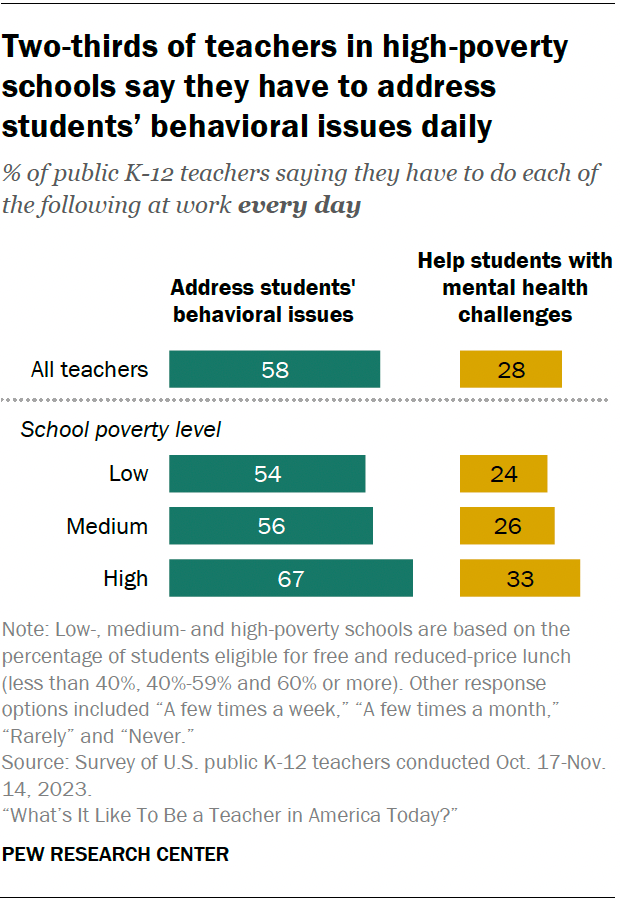
In addition to their teaching duties, a majority of teachers (58%) say they have to address behavioral issues in their classroom every day. About three-in-ten teachers (28%) say they have to help students with mental health challenges daily.
In each of these areas, elementary and middle school teachers are more likely than those at the high school level to say they do these things on a daily basis.
And teachers in high-poverty schools are more likely than those in medium- and low-poverty schools to say they deal with these issues each day.
Cellphone policies and enforcement
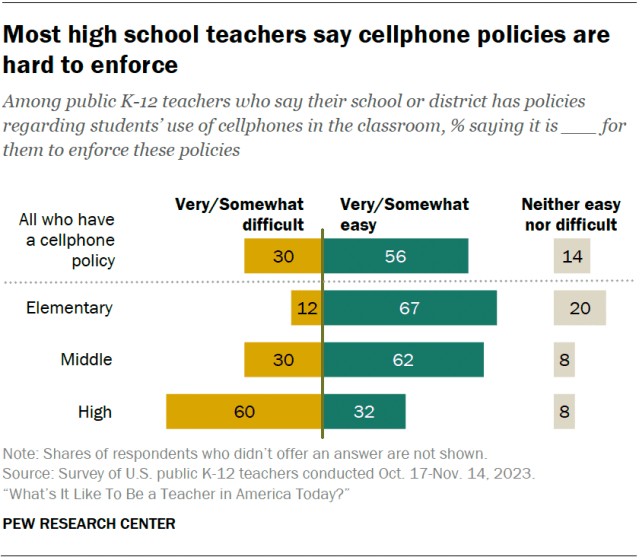
Most teachers (82%) say their school or district has policies regarding cellphone use in the classroom.
Of those, 56% say these policies are at least somewhat easy to enforce, 30% say they’re difficult to enforce, and 14% say they’re neither easy nor difficult to enforce.
Experiences with cellphone policies vary widely across school levels. High school teachers (60%) are much more likely than middle school (30%) and elementary school teachers (12%) to say the policies are difficult to enforce (among those who say their school or district has a cellphone policy).
How teachers are experiencing their jobs
Thinking about the various aspects of their jobs, teachers are most satisfied with their relationship with other teachers at their school (71% are extremely or very satisfied).
They’re least satisfied with how much they’re paid – only 15% are extremely or very satisfied with their pay, while 51% are not too or not at all satisfied.
Among teachers who don’t plan to retire or stop working this year, 29% say it’s at least somewhat likely they will look for a new job in the 2023-24 school year. Within that group, 40% say they would look for a job outside of education, 29% say they’d seek a non-teaching job in education, and only 18% say they’d look for a teaching job at another public K-12 school.
Do teachers find their work fulfilling and enjoyable?
Overall, 56% of teachers say they find their job to be fulfilling extremely often or often; 53% say their job is enjoyable. These are significantly lower than the shares who say their job is frequently stressful (77%) or overwhelming (68%).
Positive experiences are more common among newer teachers. Two-thirds of those who’ve been teaching less than six years say their work is fulfilling extremely often or often, and 62% of this group says their work is frequently enjoyable.
Teachers with longer tenures are somewhat less likely to feel this way. For example, 48% of those who’ve been teaching for six to 10 years say their work is frequently enjoyable.
Balancing the workload
Most teachers (84%) say there’s not enough time during their regular work hours to do tasks like grading, lesson planning, paperwork and answering work emails.
Among those who feel this way, 81% say simply having too much work is a major reason.
Many also point to having to spend time helping students outside the classroom, performing non-teaching duties like lunch duty, and covering other teachers’ classrooms as at least minor reasons they don’t have enough time to get all their work done.
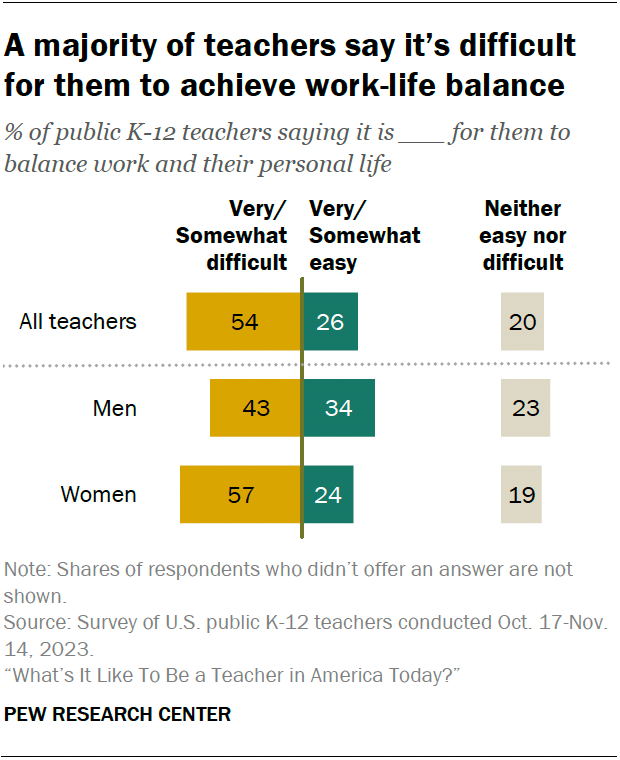
A majority of teachers (54%) say it’s very or somewhat difficult for them to balance work and their personal life. About one-in-four (26%) say it’s very or somewhat easy for them to balance these things, and 20% say it’s neither easy nor difficult.
Among teachers, women are more likely than men to say work-life balance is difficult for them (57% vs. 43%). Women teachers are also more likely to say they often find their job stressful or overwhelming.
How teachers view the education system
A large majority of teachers (82%) say the overall state of public K-12 education has gotten worse in the past five years.
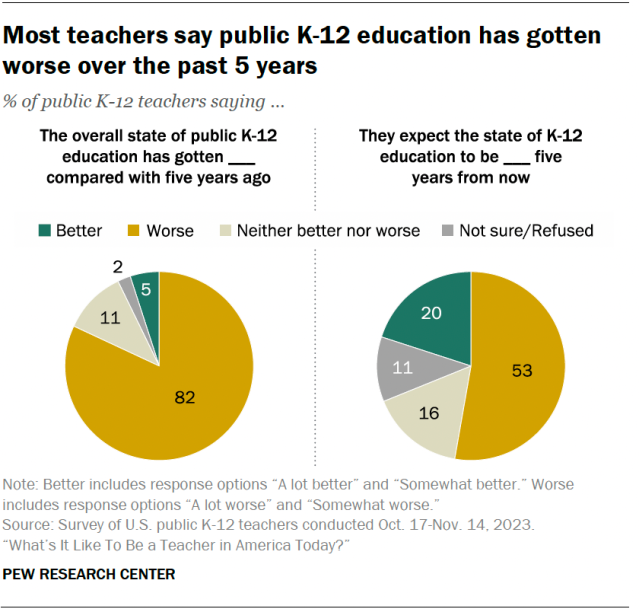
And very few are optimistic about the next five years: Only 20% of teachers say public K-12 education will be a lot or somewhat better five years from now. A narrow majority (53%) say it will be worse.
Among teachers who think things have gotten worse in recent years, majorities say the current political climate (60%) and the lasting effects of the COVID-19 pandemic (57%) are major reasons. A sizable share (46%) also point to changes in the availability of funding and resources.
Related: About half of Americans say public K-12 education is going in the wrong direction
Which political party do teachers trust more to deal with educational challenges?
On balance, more teachers say they trust the Democratic Party than say they trust the Republican Party to do a better job handling key issues facing the K-12 education system. But three-in-ten or more across the following issues say they don’t trust either party:
- Shaping school curriculum (42% say they trust neither party)
- Ensuring teachers have adequate pay and benefits (35%)
- Making schools safer (35%)
- Ensuring adequate funding for schools (33%)
- Ensuring all students have equal access to high-quality K-12 education (31%)
A majority of public K-12 teachers (58%) identify or lean toward the Democratic Party. This is higher than the share among the general public (47%).
- Poverty levels are based on the percentage of students in the school who are eligible for free and reduced-price lunch. ↩
- For details, refer to the Methodology section of the report. ↩
- Urban, suburban and rural schools are based on the location of the school as reported by the National Center for Education Statistics (rural includes town). Definitions match those used by the U.S. Census Bureau. ↩
Social Trends Monthly Newsletter
Sign up to to receive a monthly digest of the Center's latest research on the attitudes and behaviors of Americans in key realms of daily life
Report Materials
Table of contents, ‘back to school’ means anytime from late july to after labor day, depending on where in the u.s. you live, among many u.s. children, reading for fun has become less common, federal data shows, most european students learn english in school, for u.s. teens today, summer means more schooling and less leisure time than in the past, about one-in-six u.s. teachers work second jobs – and not just in the summer, most popular.
About Pew Research Center Pew Research Center is a nonpartisan fact tank that informs the public about the issues, attitudes and trends shaping the world. It conducts public opinion polling, demographic research, media content analysis and other empirical social science research. Pew Research Center does not take policy positions. It is a subsidiary of The Pew Charitable Trusts .

Worcester councilor seeks report on cost of adding middle school to Burncoat project
W ORCESTER — A city councilor is asking the city's chief financial officer to provide a report on the debt associated with all major projects in the city, including the planned replacement of Burncoat High School.
District 3 Councilor George Russell also requested the report include a projection of how adding Burncoat Middle School to the Burncoat High School proposal would affect the debt.
"On any of these buildings … part of the taxes that are collected go toward paying the debt," Russell said.
"I'm asking for the administration to assure us on a chart what the debt services would be for everything we have now. What the debt service would be for Burncoat – which they already have in projections where they've talked about it informally – and then to factor in Burncoat Junior High."
The Massachusetts School Building Authority voted last year to approve making replacing Burncoat High School eligible for state funding. The school district has indicated that replacing the high school is its highest-priority construction project.
Since 2006, when construction of a new Worcester Technical High School building was completed, the district has also seen the construction and opening of a new North High School in 2011 and South High Community School in 2021 .
A new Doherty Memorial High School is under construction and is slated to open fall of 2024.
Russell said Worcester East Middle School is also in need of renovations; school department chief communications officer Dan O'Brien says East is a high priority for facility upgrades.
"My feeling was always that Worcester East Middle School should be next in line behind Burncoat," Russell said.
The school district has received funding to replace all the school's windows in 2025. The school's boiler system was replaced in 2013, and in 2021 the school got a new roof from city, with the state contributing funding.
"There's been talk about [East Middle School] with some members and myself about some improvements that I believe are in the works from the state," Russell said. "One time, a few years ago, I remember sitting in the auditorium and walking around and seeing chipped paint. I walked through the hallways and there's plastic sheets duct-taped over windows. They at least deserve some improvements."
This article originally appeared on Telegram & Gazette: Worcester councilor seeks report on cost of adding middle school to Burncoat project

Former Central WR Joe Griffin enters transfer portal after two seasons at Boston College (report)
- Updated: Apr. 13, 2024, 11:01 a.m. |
- Published: Apr. 12, 2024, 4:39 p.m.

Former Springfield Central football player Joe Griffin Jr. (left), now at Boston College, during a game against Virginia Tech in Chestnut Hill on Nov. 11, 2023. David Hosmer
- Christopher Berry | [email protected]
According to ESPN’s Pete Thamel , former Springfield Central and Boston College wide receiver Joseph Griffin Jr. has entered the transfer portal after two seasons with the Eagles.
He was a four-star recruit who chose to attend Chestnut Hill versus other Division I schools in Notre Dame, Virginia, Duke, Wisconsin, Wake Forest, and UMass.
If you purchase a product or register for an account through a link on our site, we may receive compensation. By using this site, you consent to our User Agreement and agree that your clicks, interactions, and personal information may be collected, recorded, and/or stored by us and social media and other third-party partners in accordance with our Privacy Policy.

IMAGES
VIDEO
COMMENTS
A Simple Biography Report. Help your student thoughtfully remember facts from these middle school biographies with this free one-page biography report. This simple report is perfect for your tween or teen to use to record what they learn as they read. It's an easy (and fun!) way to report their reading.
Biography Report Form. To help direct their learning, encourage your tween to use this biography report template. It's a wonderful tool that will help them dive deeper into the life of an extraordinary person and learn how to organize research material. Middle School Biography Books. A biography is the perfect type of book for inquisitive kids.
Take notes on your person using the 5 Ws or Who, What, When, Where, and Why. Use the writing frames to start writing your paragraphs. Type up your writing frames into one complete draft. Participate in a peer review with a checklist. Submit a completed type 3 writing draft.
40 Biography Questions that Kids Can Ask When Writing Biography Reports. Social Studies. When teaching kids about history, few topics captivate and engage young learners more than biographies. Kids love learning about real people who have made a difference in our lives. Asking the right questions is key for students as they explore the life ...
Biography Report Form Template and Organizer. 920. A biography is the story of a person's life. Because of their unique and personal nature, I often choose to include biographies for middle school in our studies of significant historical events. By reading about someone's personal history and connection to an event, my teens gain valuable ...
Step 1: Read a Biography. The first step for students before writing a biography is to read one. They need to see a real-life example before tackling their own biography assignment. Elementary students can read biography picture books or Who Was? biography novels.
Overview. Set the stage for high-interest reading with a purpose through a biography project. Students work together to generate questions they would like to answer about several well-known people, then each student chooses one of these and finds information by reading a biography from the library and doing Internet research.
Middle and high school teachers should allow students to have a choice in selecting the subject for a biography. Providing student choice, particularly for students in grades 7-12, increases their engagement and their motivation especially if students select individuals they care about.
Crafting the Body Paragraphs of the Biography Report. When teaching your students to write biography reports, it is important to explain to them what the body paragraphs should include. The body paragraphs should include the major events in the person's life. Read over the body paragraphs from your mentor text and discuss what was included ...
Biography Book Report Graphic Organizer Subject: Students can use this fun graphic organizer to record the following about the person they are researching: important characteristics, important contributions, things to admire about this person, reasons this person is famous, and experiences that made thi s person important. ...
The Final Report. For the final report, students develop a full biography report using my The following graphic organizers and reports can be found in my Biography Report for ANY Person resource. You can see detailed examples in this blog post. Students use the craft during their oral reports in front of the class.
A biography is a story about a particular person's life, whether it be a famous person, athlete, historical figure, or a specific person. Biographies of people are written in third person, meaning it is about someone else. In contrast, an autobiography is a person themselves telling their life story.
The free biography report template provided below can be used as a jumping off point. The websites listed to accompany the research template are student friendly and filled with tons of options for researching an influential figure. If your students do well with the template, it can be used as an outline for an expository writing assignment.
Misty Copeland: First African American Principal Ballerina for the American Ballet Theatre. Lincoln's Spymaster: Allan Pinkerton, America's First Private Eye. eAudiobook. Child of the Dream: A Memoir of 1963. When Stars Are Scattered.
Include a drawing of your character, the title of the biography, and the author of the biography. Tell the date and place where your character was born and raised. Describe the early life of your character. Things like where their grew up, their education, family, and jobs. Tell about what kind of person he or she was.
3. 2. 1. Theme. My biography has a theme that reflects what is unique, interesting, and important about the person I am writing about. My biography attempts to have a theme but generally just has a topic. My biography has a topic, rather than a theme. My biography is about many different topics.
Include a drawing of your character, the title of the biography, the author of the biography and your name. Tell the date and place where your character was born and raised. Don't include too many family details or details about habits and hobbies that don't have anything to do with their later work. Describe the early life of your character.
A biography is an account of someone's life written by someone else.While there is a genre known as a fictional biography, for the most part, biographies are, by definition, nonfiction. Generally speaking, biographies provide an account of the subject's life from the earliest days of their childhood to the present day or their death if the subject is deceased.
This is a great book report rubric for a middle school workshop classroom! Students select the biography of their choice, read it independently, and take notes in preparation for the bio bag book report. The presentation includes a timeline, picture, and 6 symbol cards, each sold separately. This file is the grading rubric only.
Fact Monster's Homework Center discusses each section of a book report, and explains how to evaluate and analyze books based on genre for students in middle and high school. "Middle School Outline Template for Book Report" (Trinity Catholic School) This PDF outline template breaks the book report down into manageable sections for seventh and ...
middle school book report. ... Biography Book Report Template. Open with Kami. Download for free. Split & Merge this template with your teaching resources. Description. Streamline your book report writing with our pre-made template! Cover all the crucial aspects of the book including plot summary, character analysis, and personal opinions. A ...
This is a complete unit for either middle school or high school students to write a biography (MLA style) Pages include: * Chunked outline with room for due dates. * Instruction sheet that summarizes each part of the assignment (Thesis, research, outline, rough drafts, final) * Examples of source/note cards. * Information on Work Cited page.
Biography Report. Create a report in Microsoft Word about a famous person that you can find information about at Wikipedia.org or Google.com. Download the document for your notes. Video #1 - Pick the person and prepare the notes about the individuals personal like and why he or she is famous. Below is an example of notes on a famous person.
Brighton, N.Y. — Police said a report of someone with a shotgun, which they now believe may have been an umbrella, prompted a lockout in three Brighton Central School District buildings Thursday.
Pew Research Center conducted this study to better understand the views and experiences of public K-12 school teachers. The analysis in this report is based on an online survey of 2,531 U.S. public K-12 teachers conducted from Oct. 17 to Nov. 14, 2023. ... By comparison, 46% of middle school teachers and 43% of elementary school teachers say ...
District 3 Councilor George Russell also requested the report include a projection of how adding Burncoat Middle School to the Burncoat High School proposal would affect the debt.
According to ESPN's Pete Thamel, former Springfield Central and Boston College wide receiver Joseph Griffin Jr. has entered the transfer portal after two seasons with the Eagles.. He was a four ...